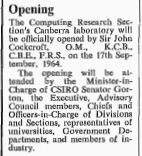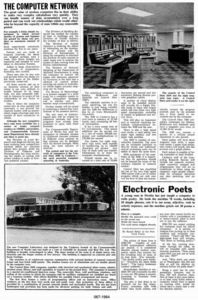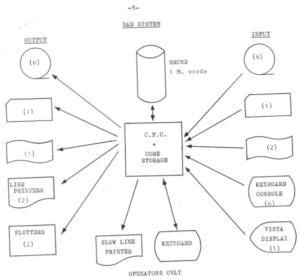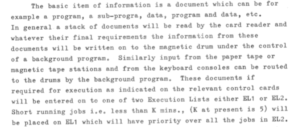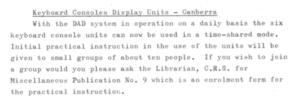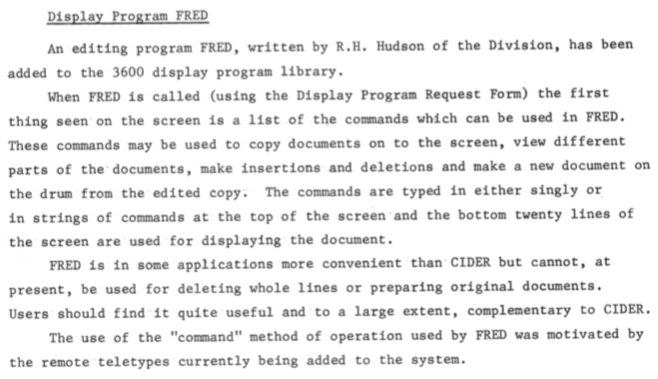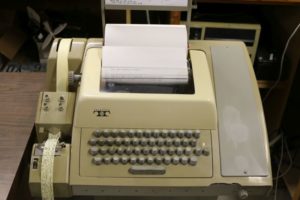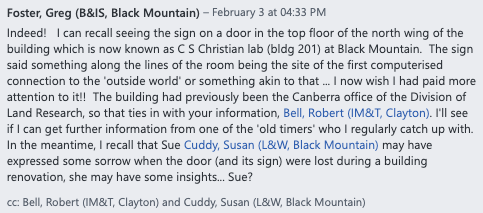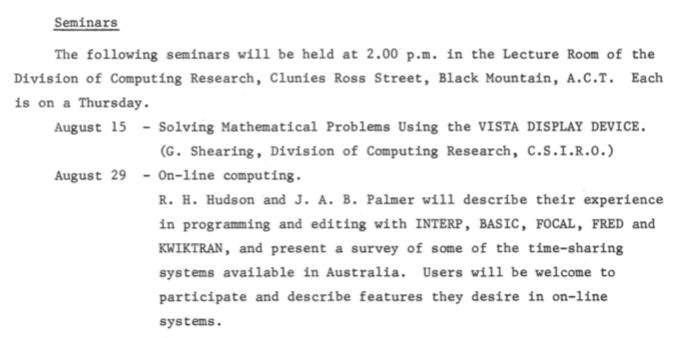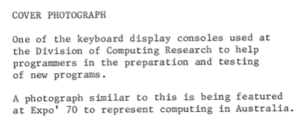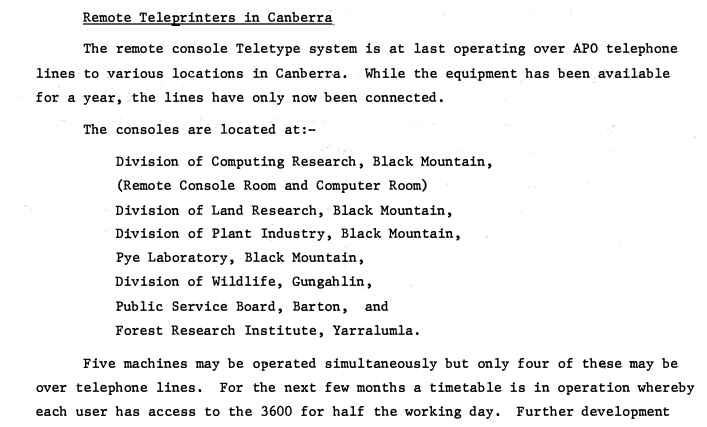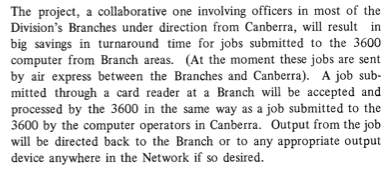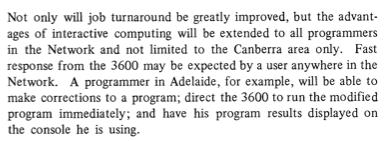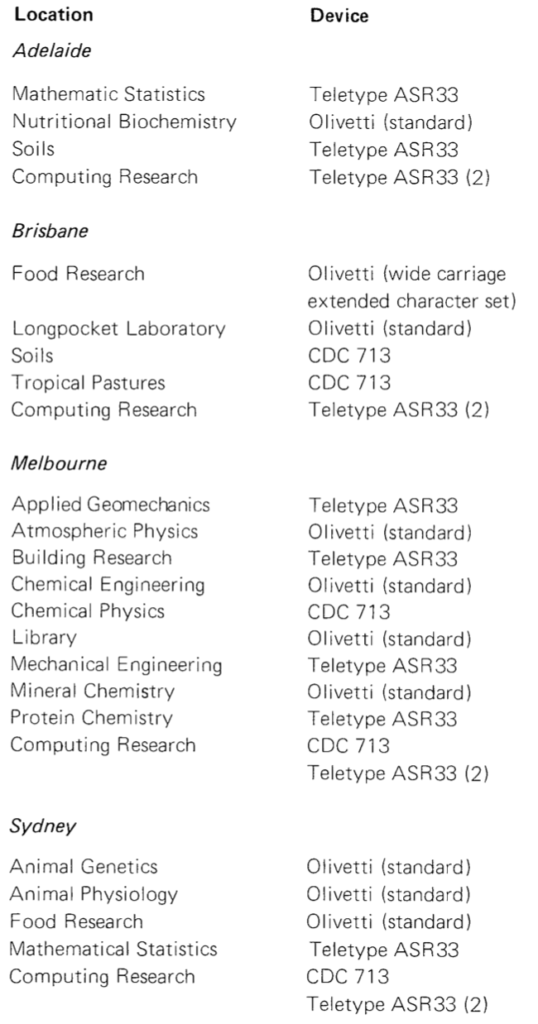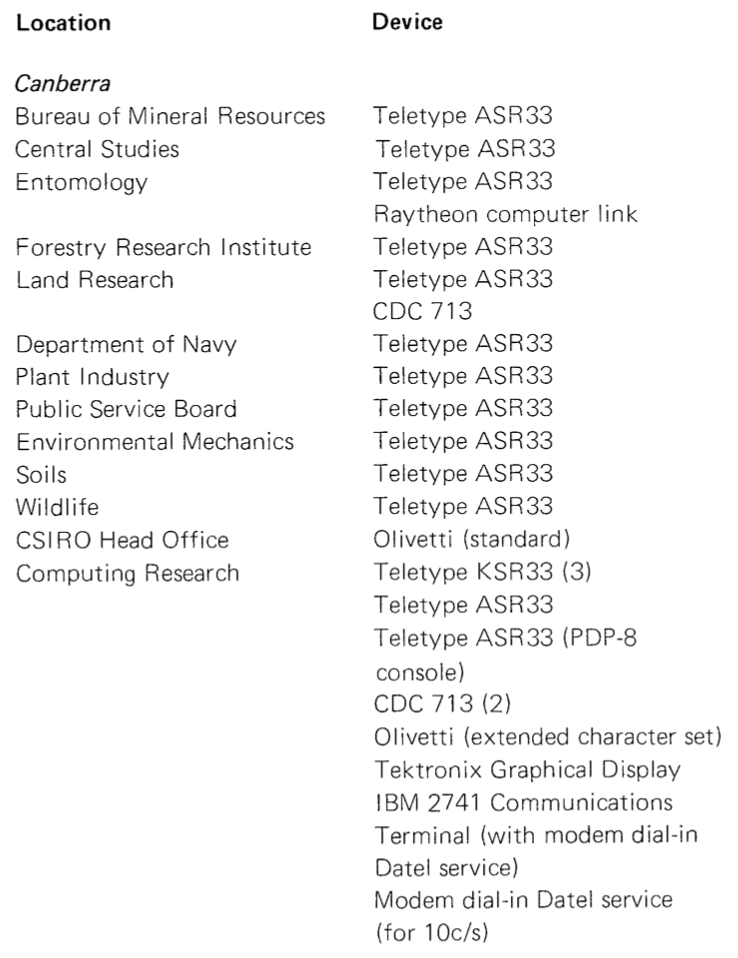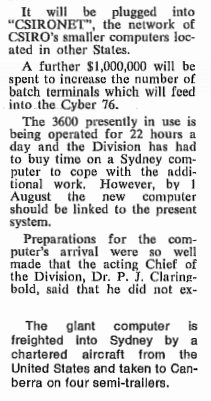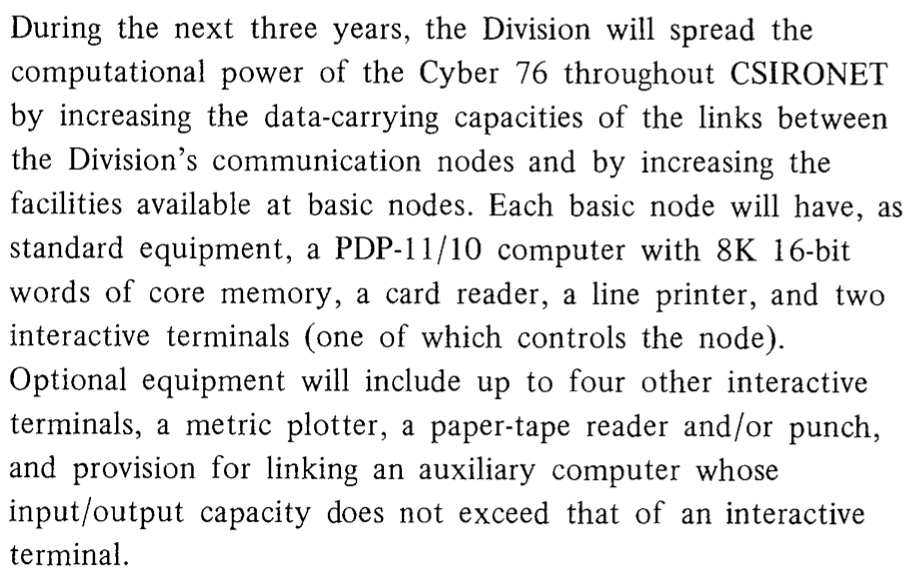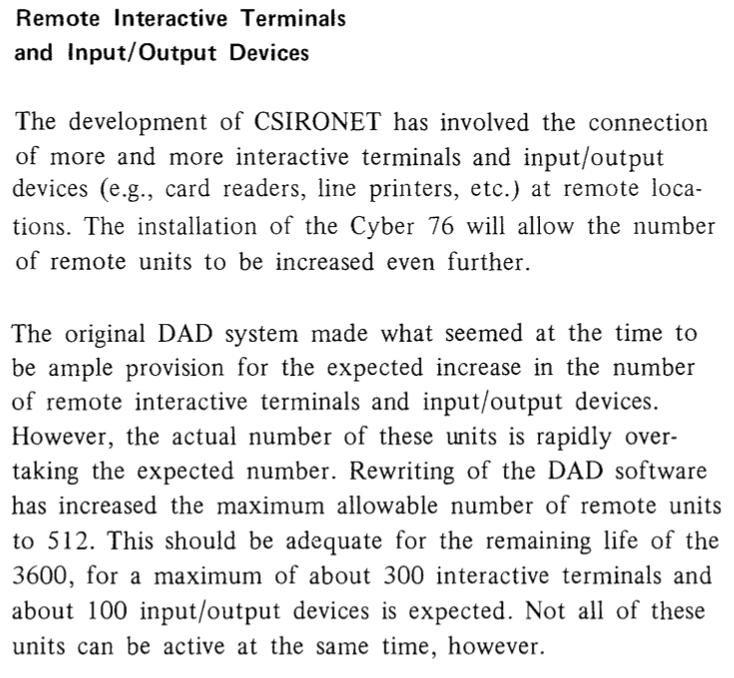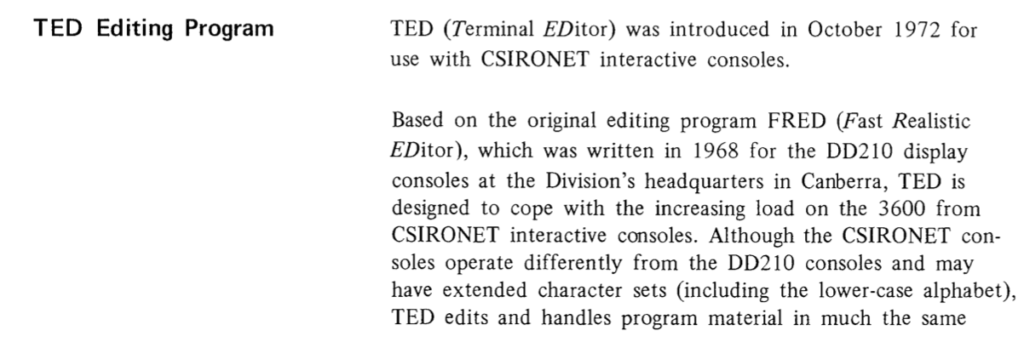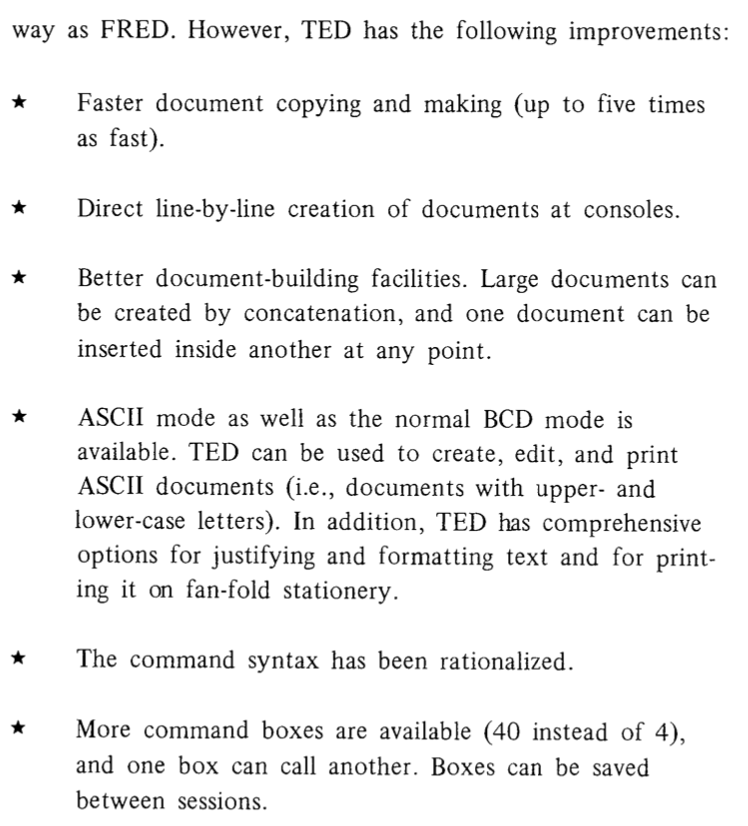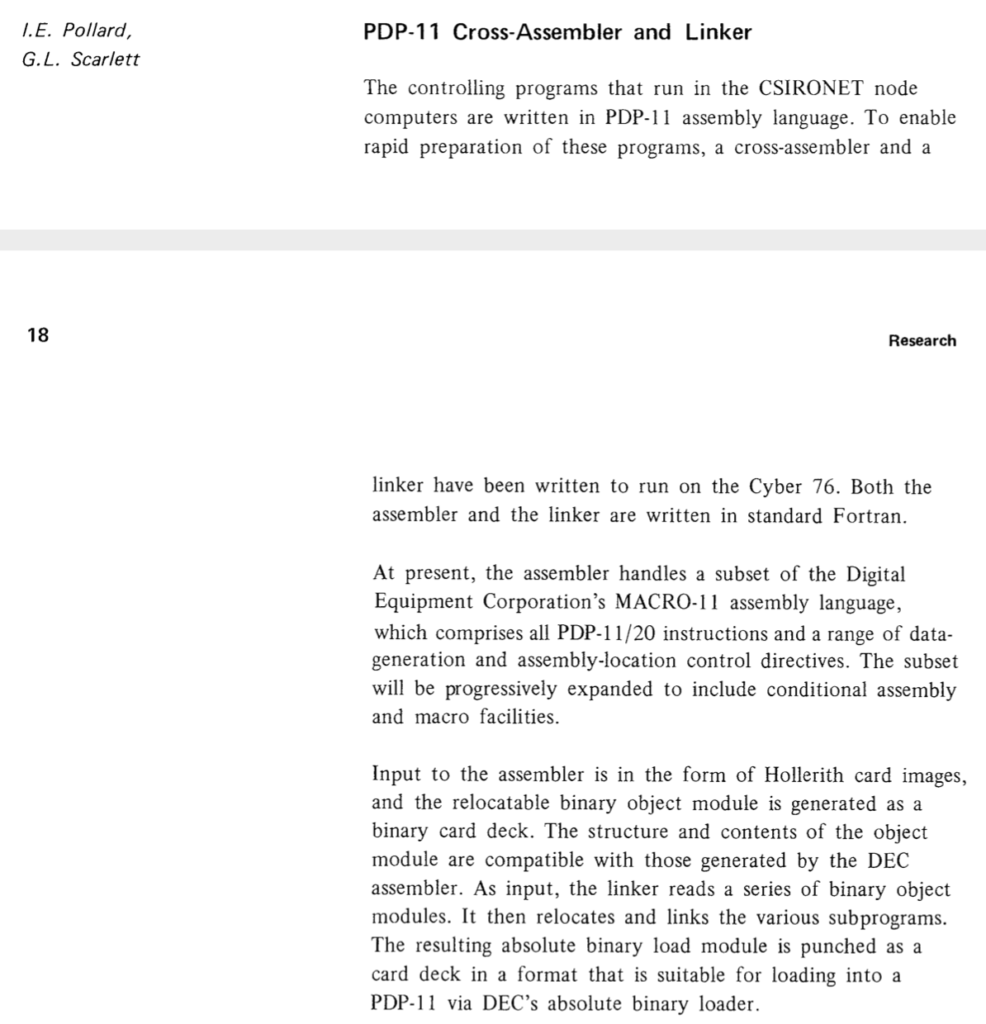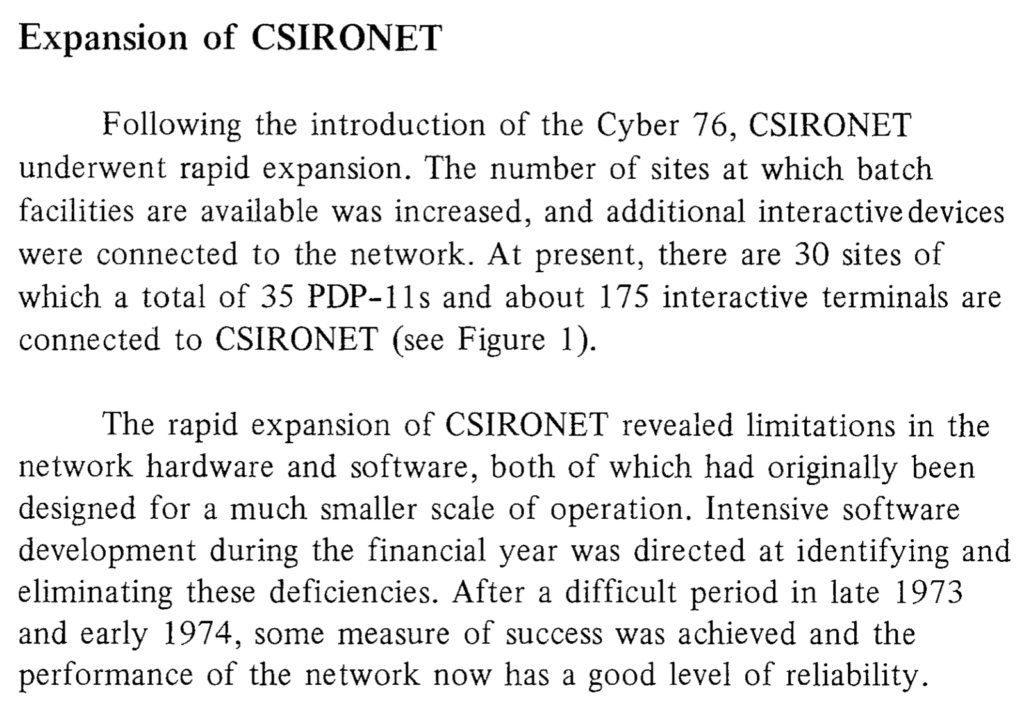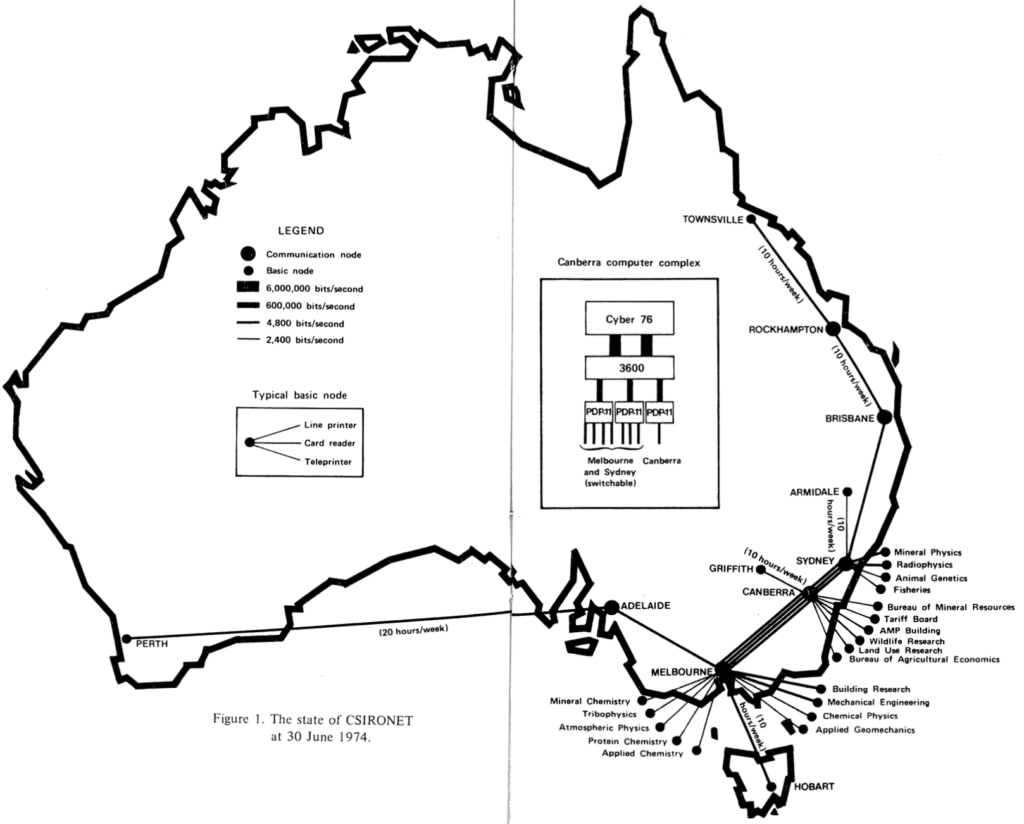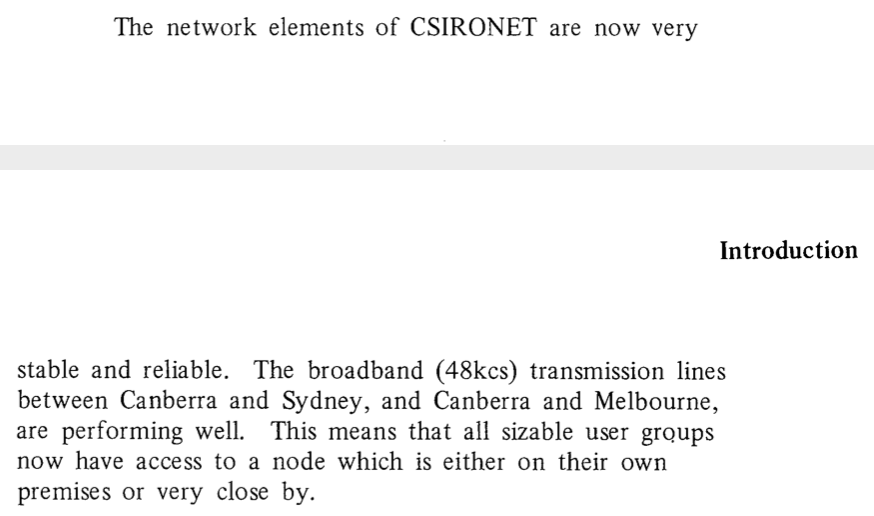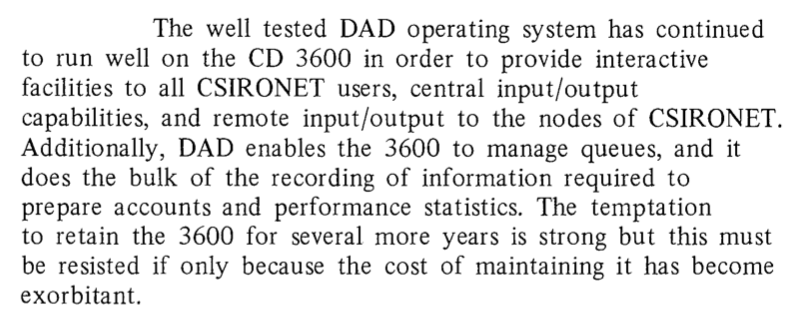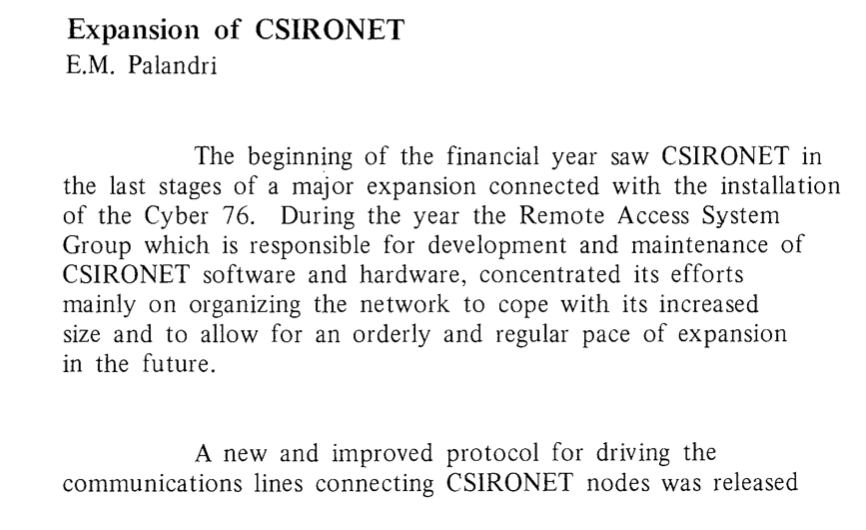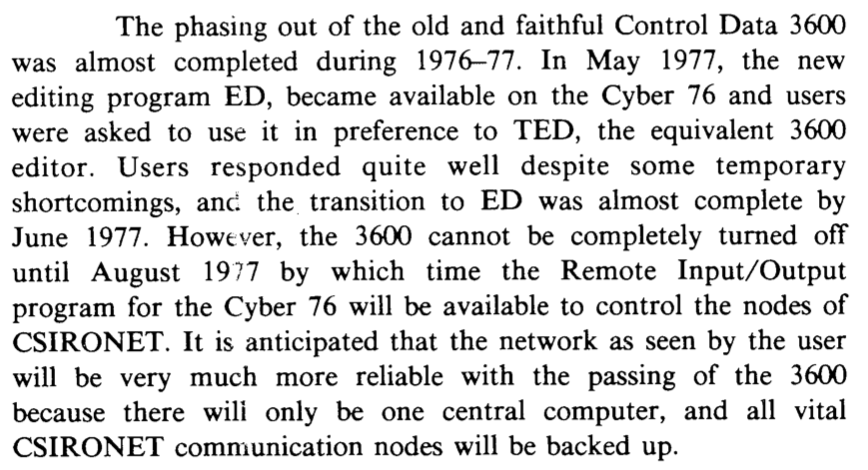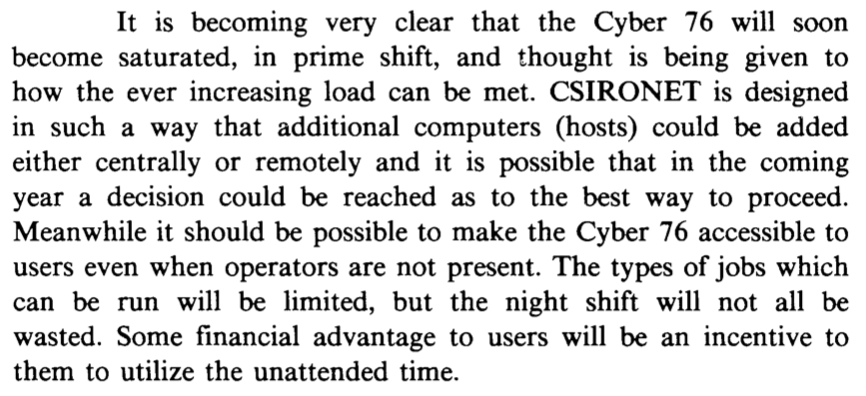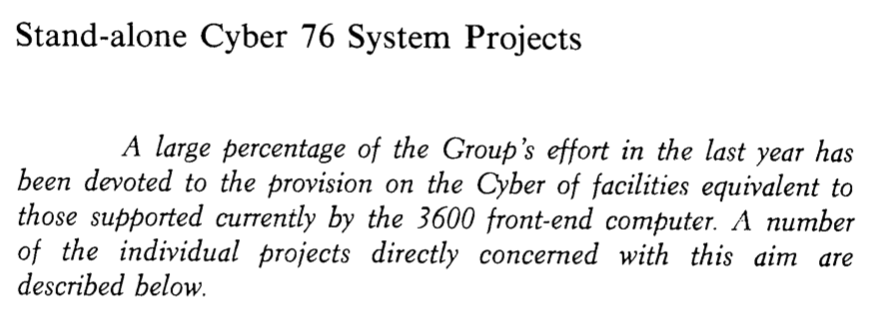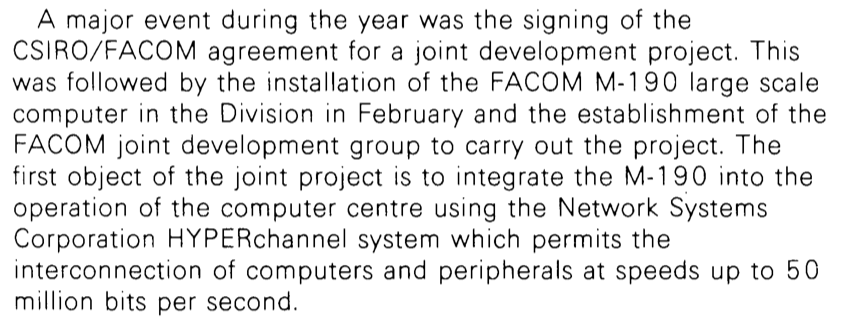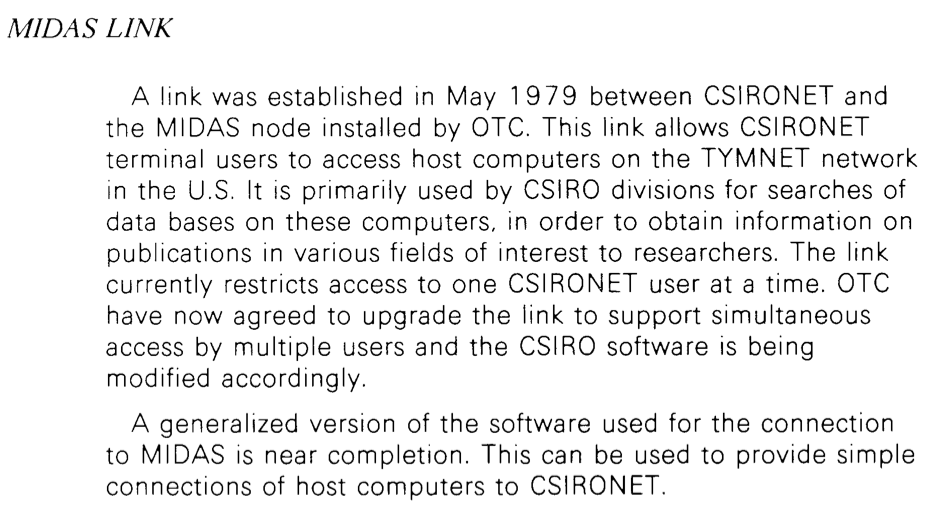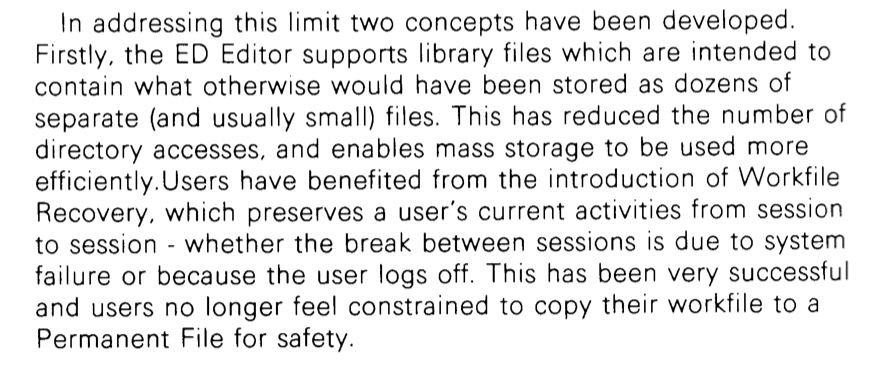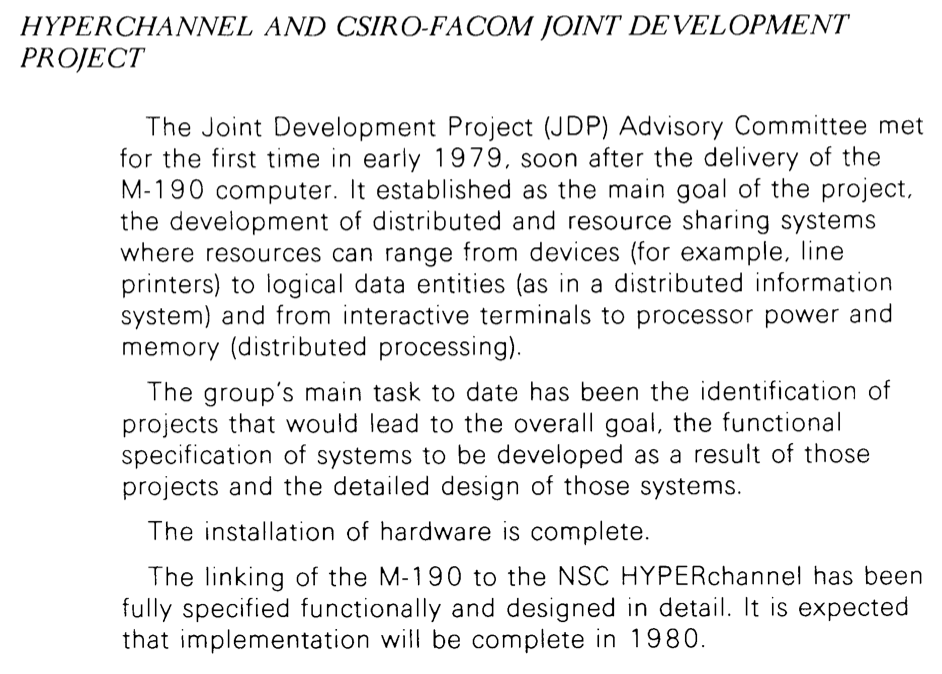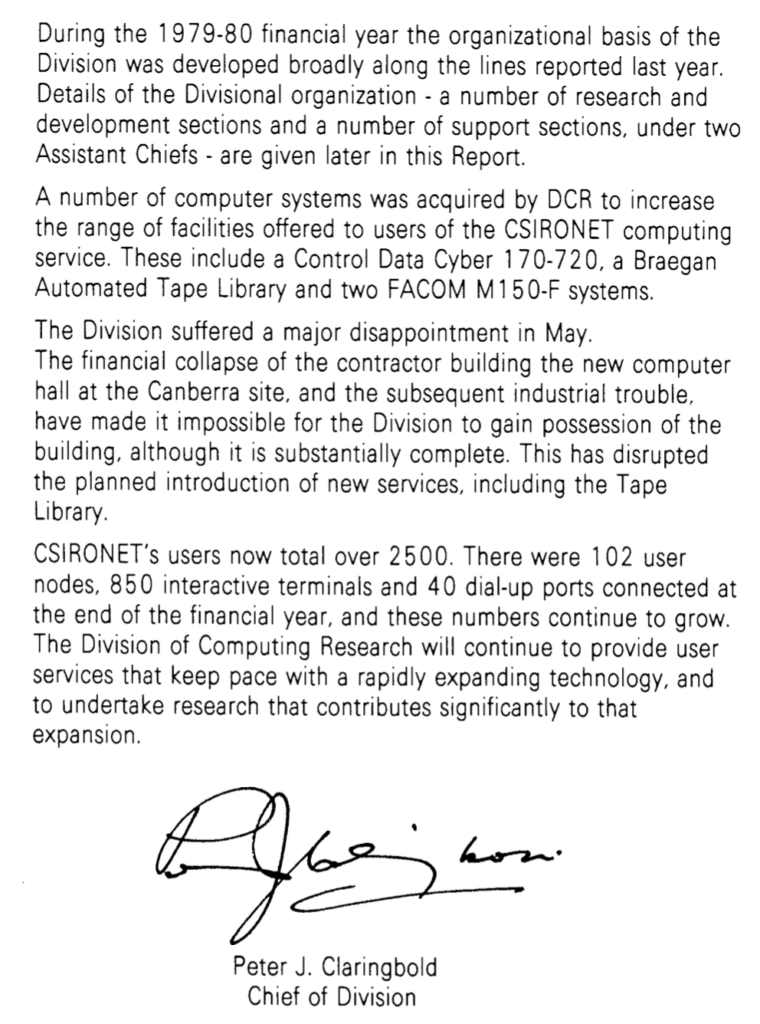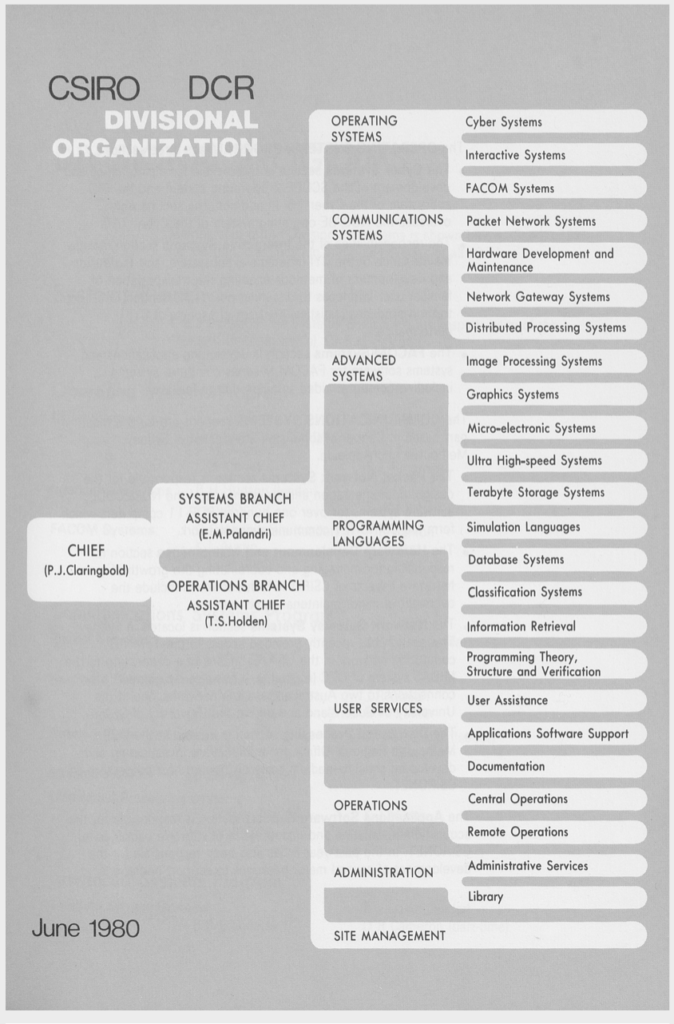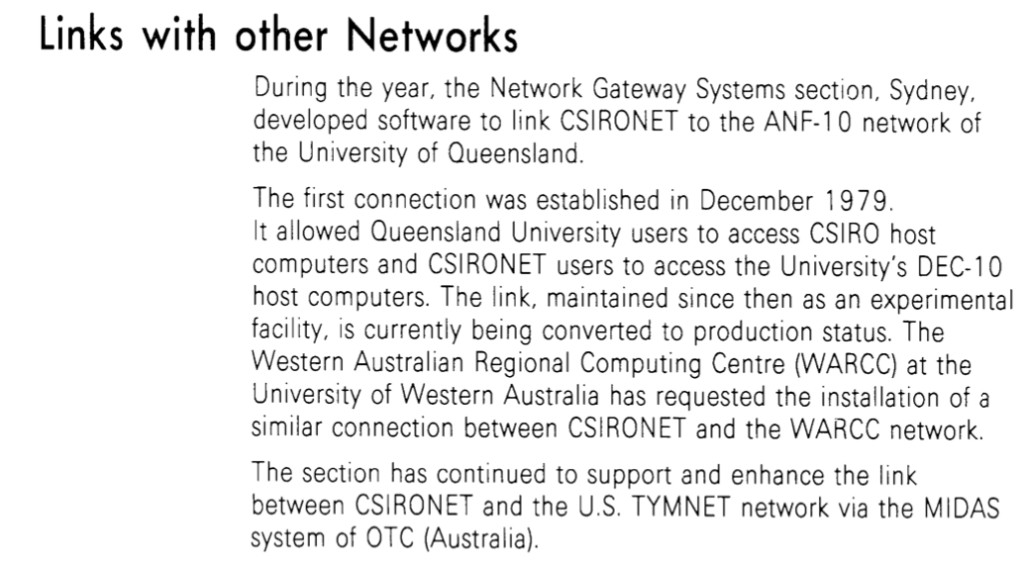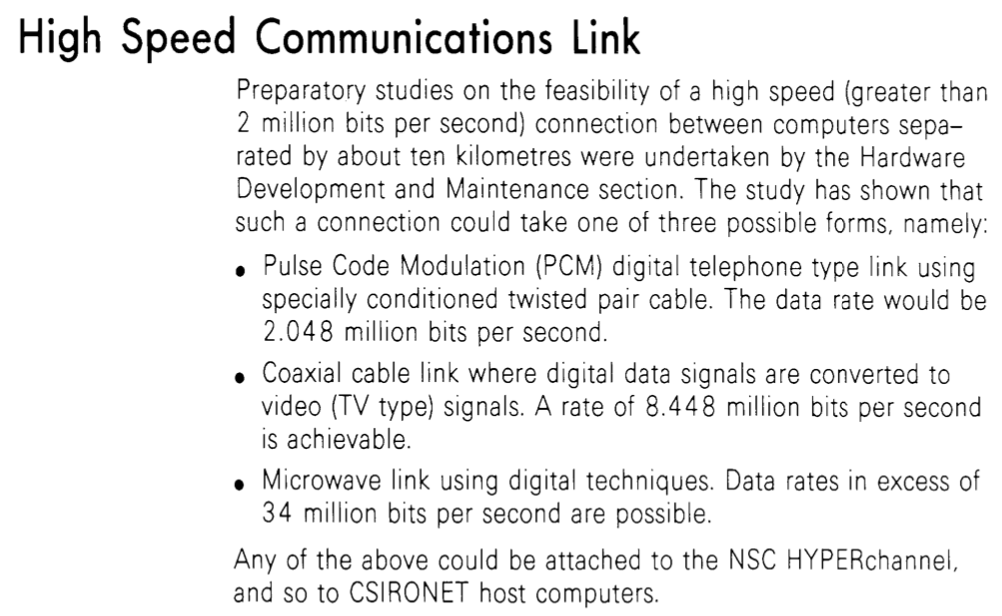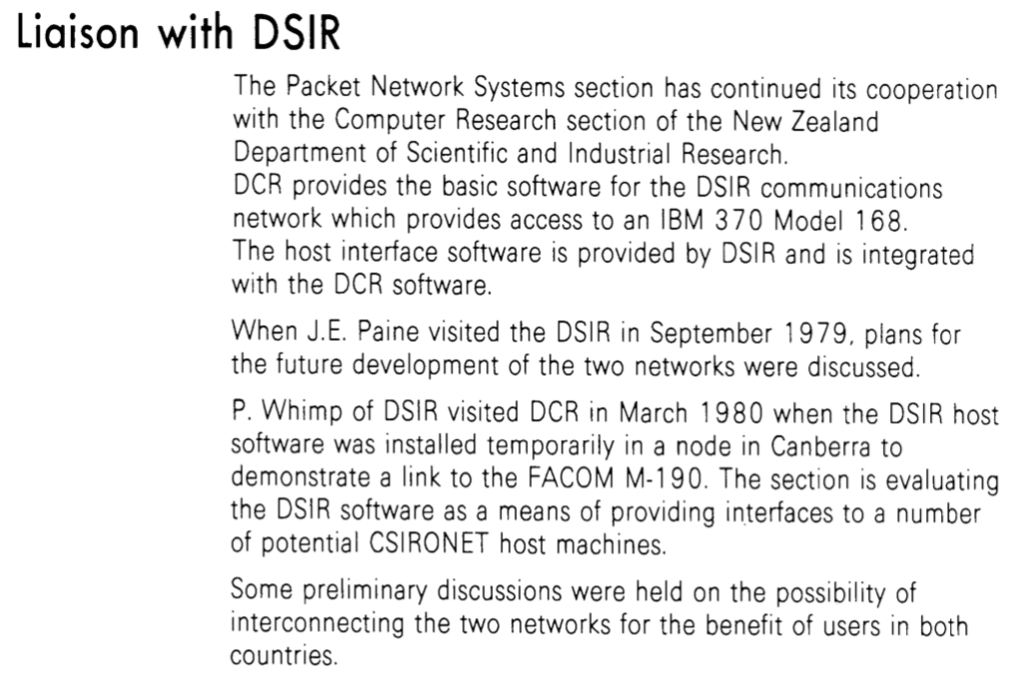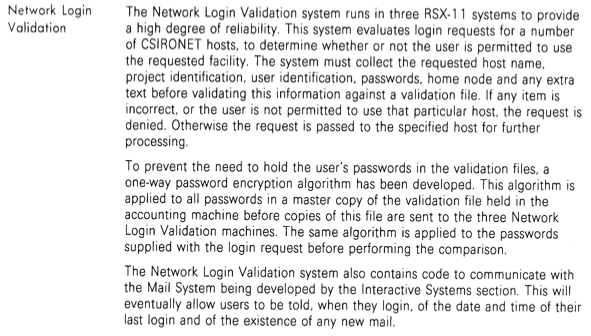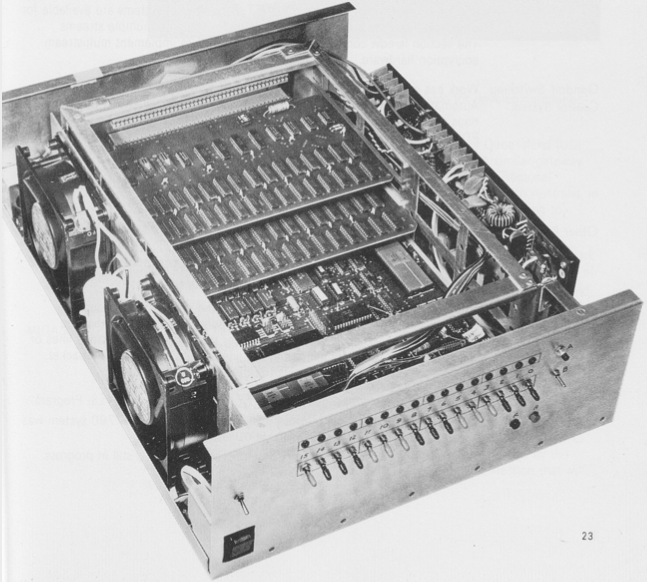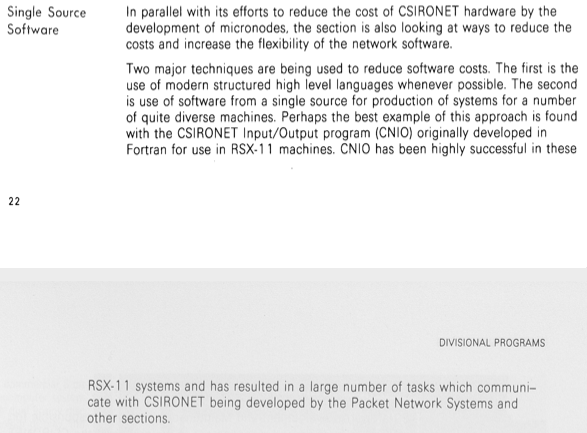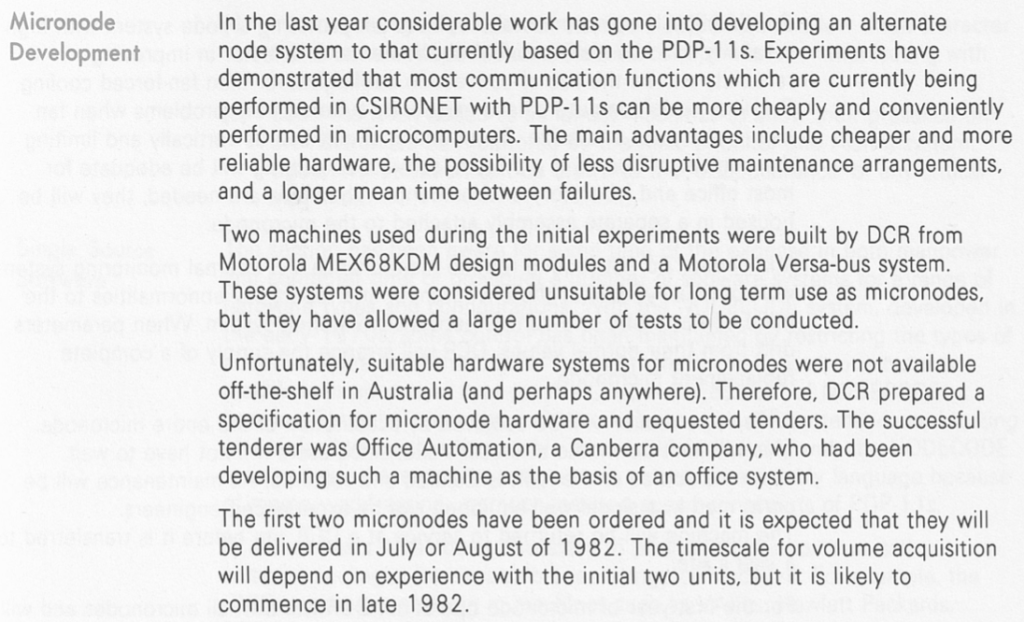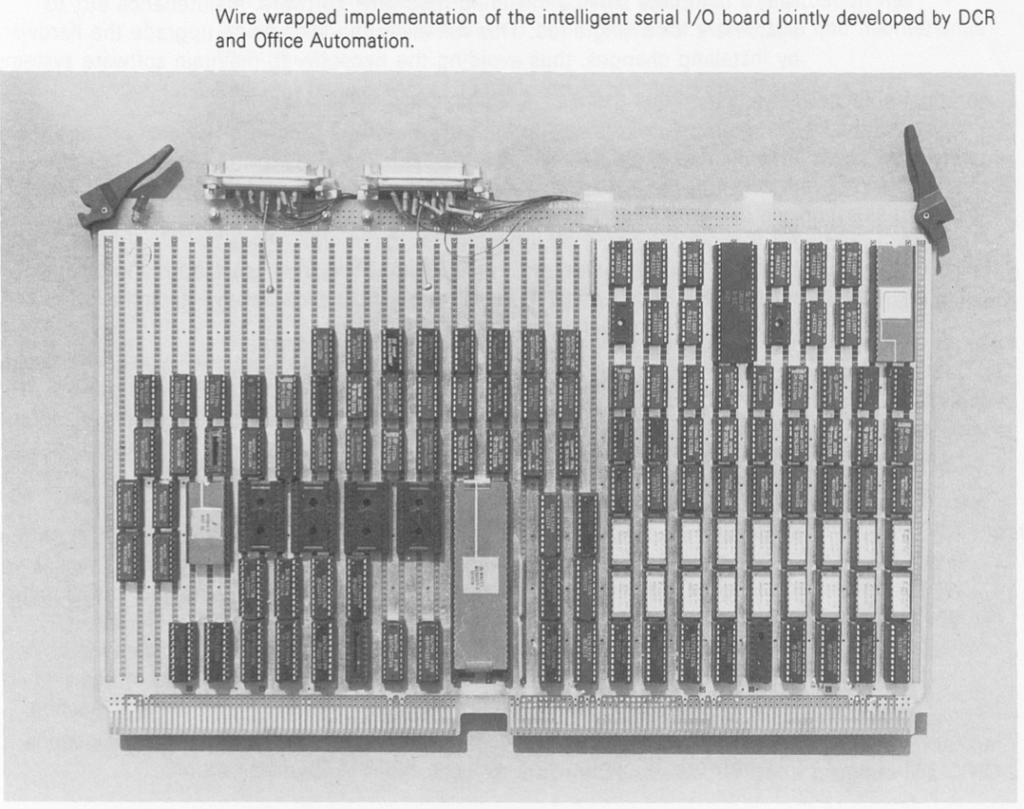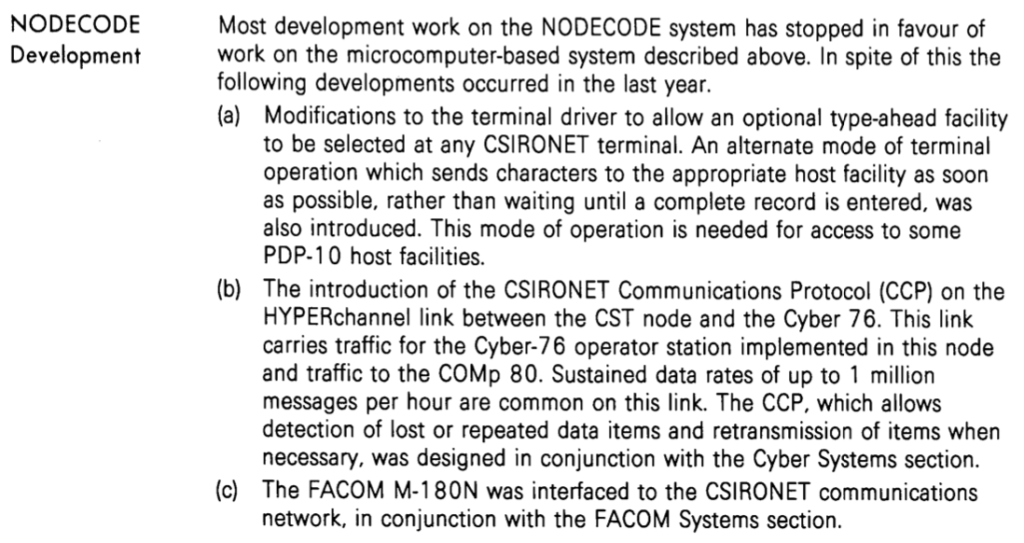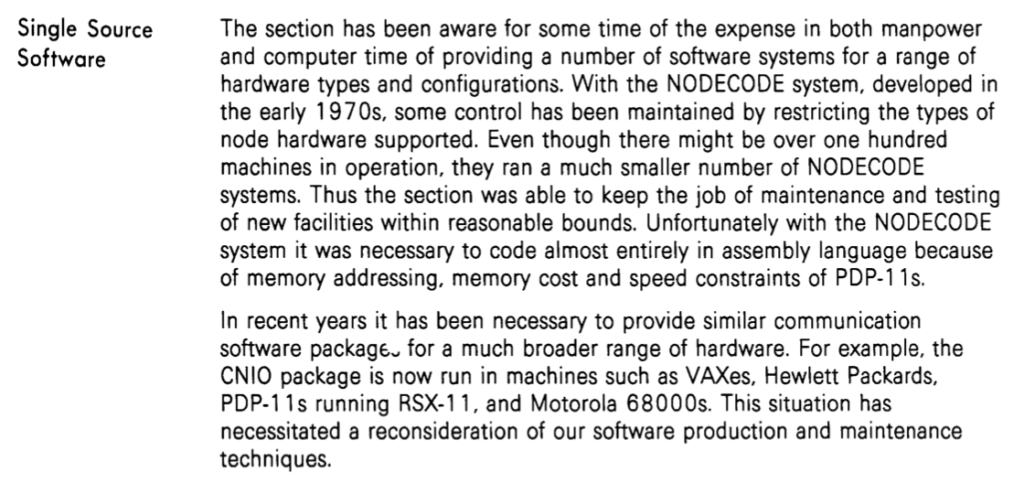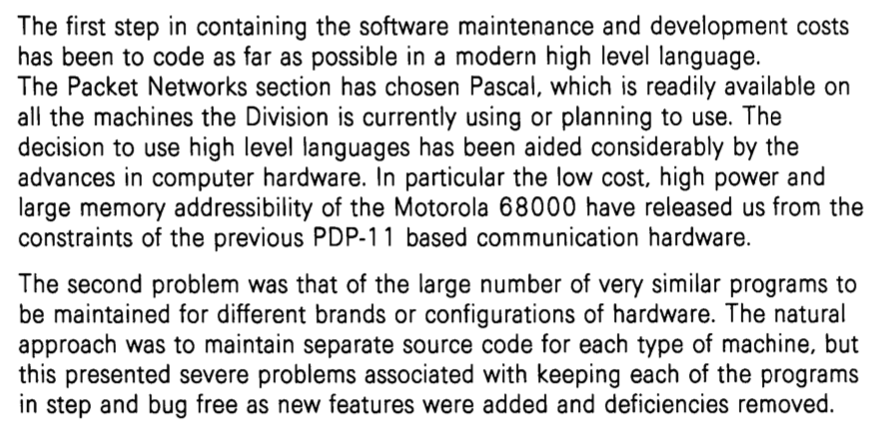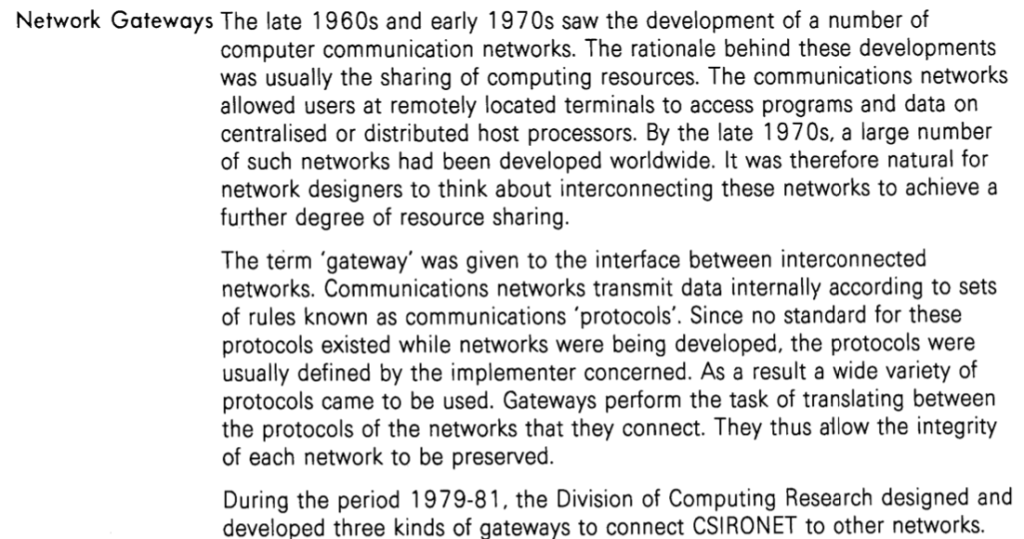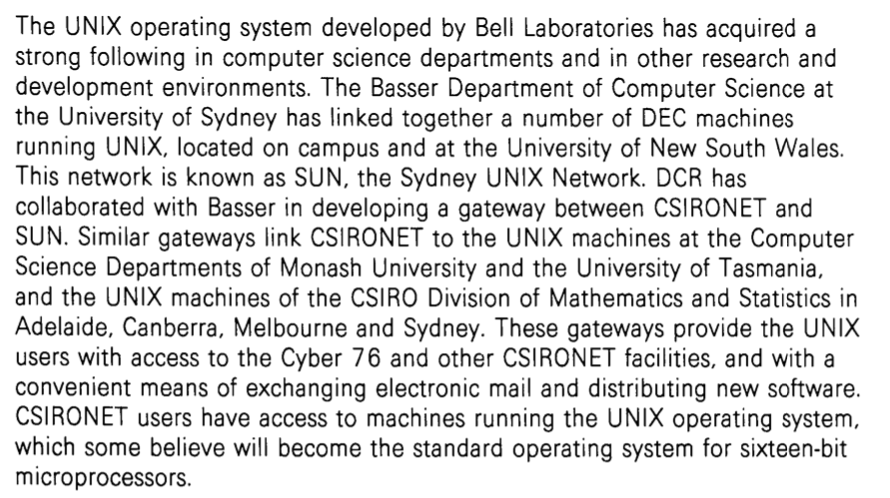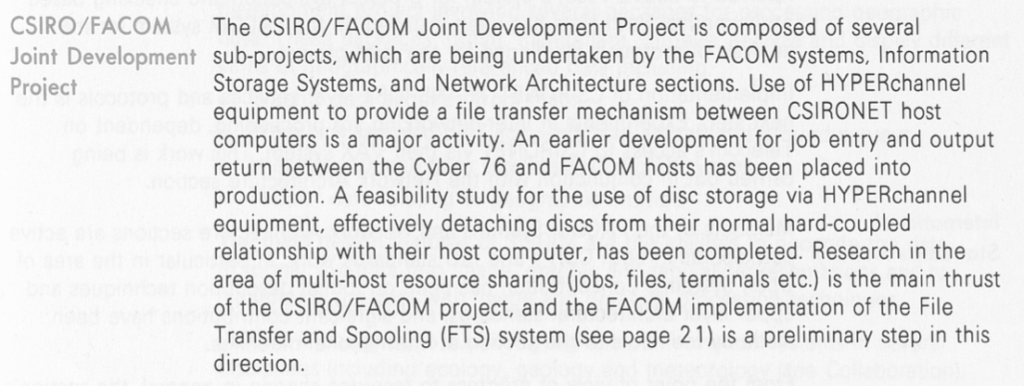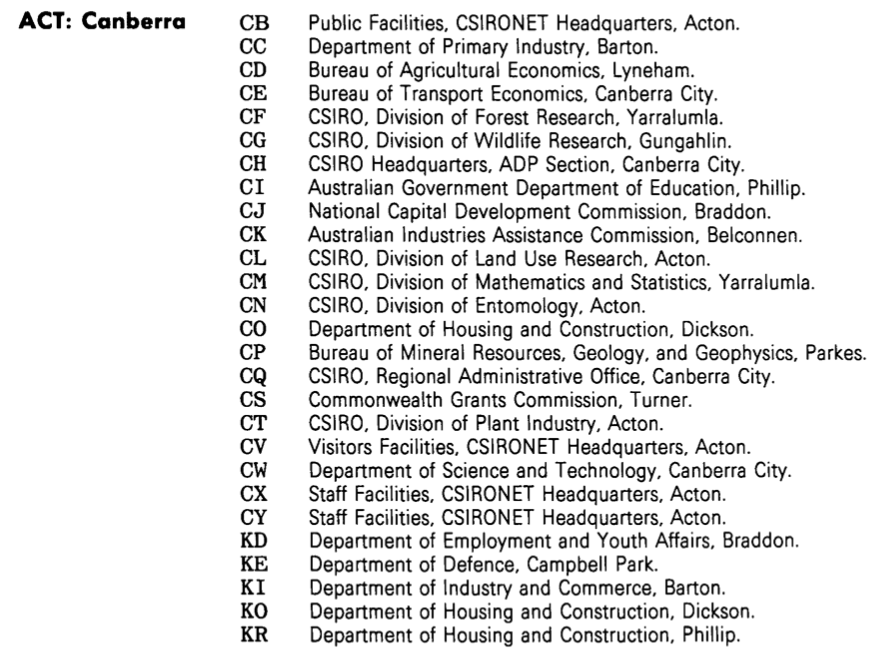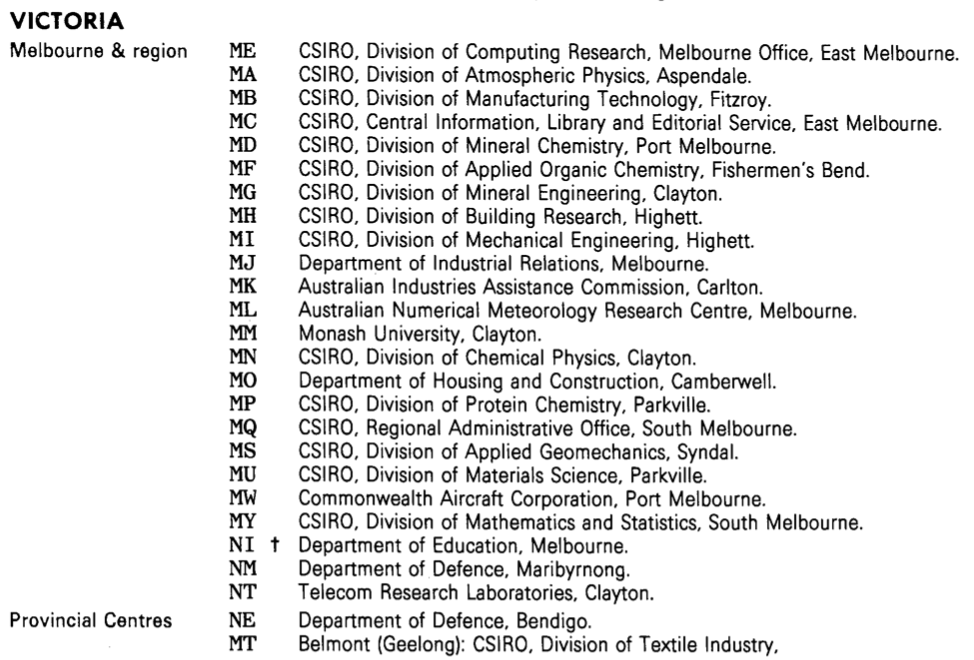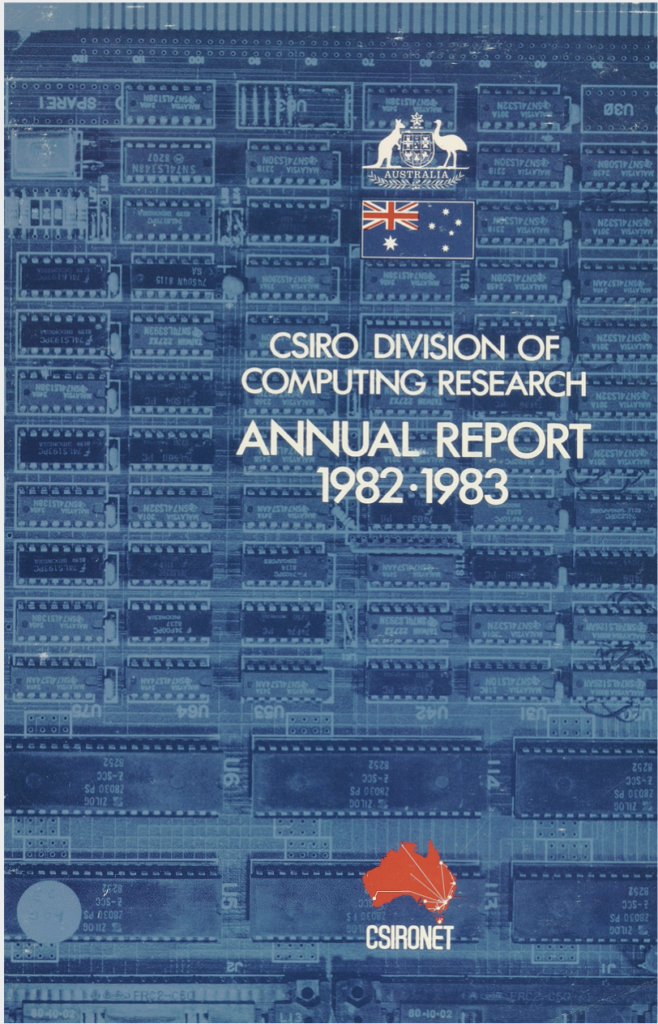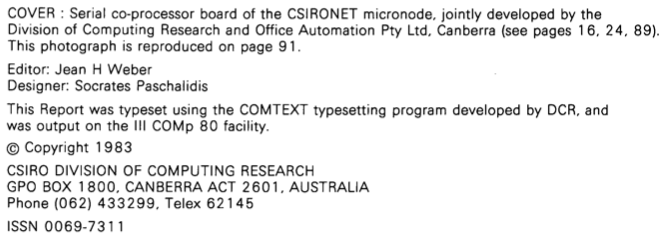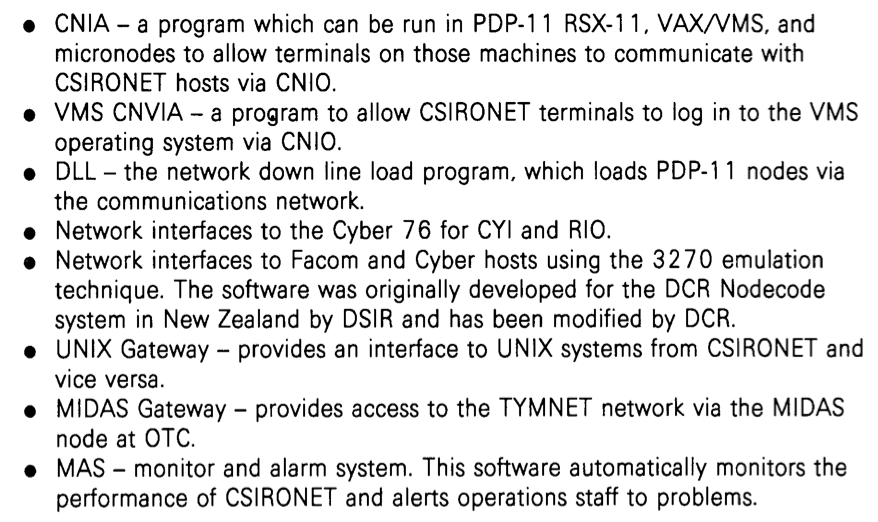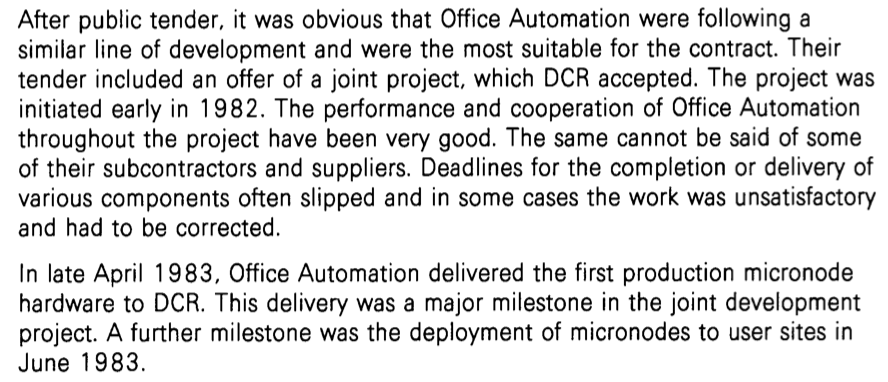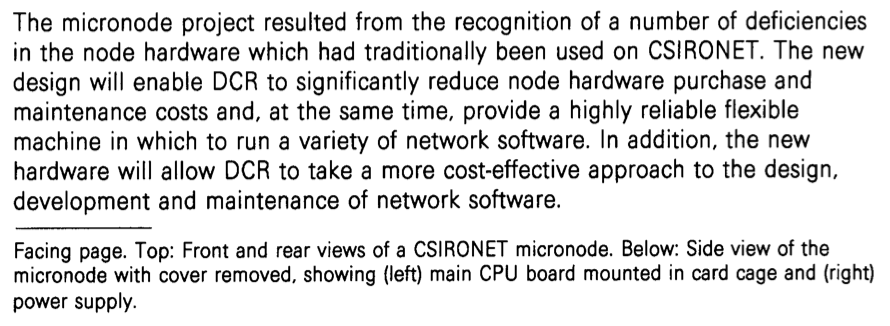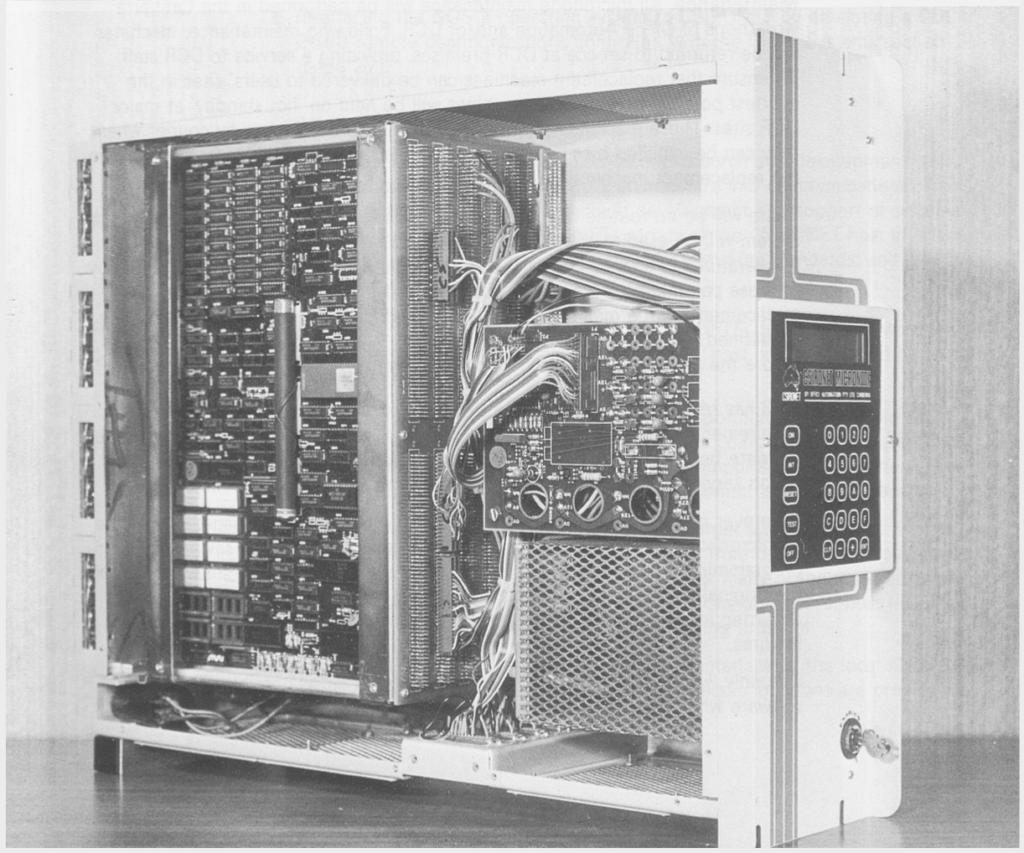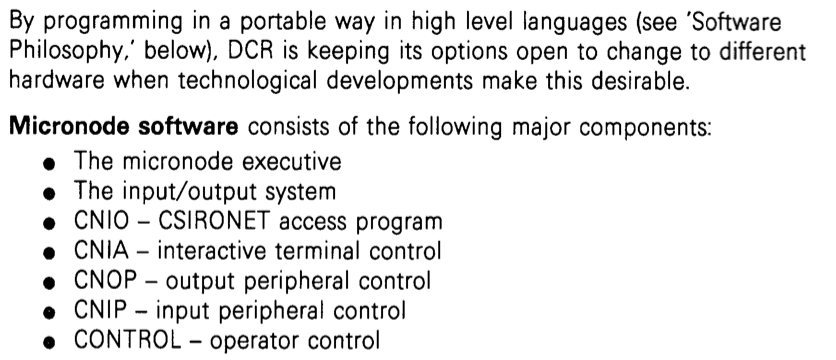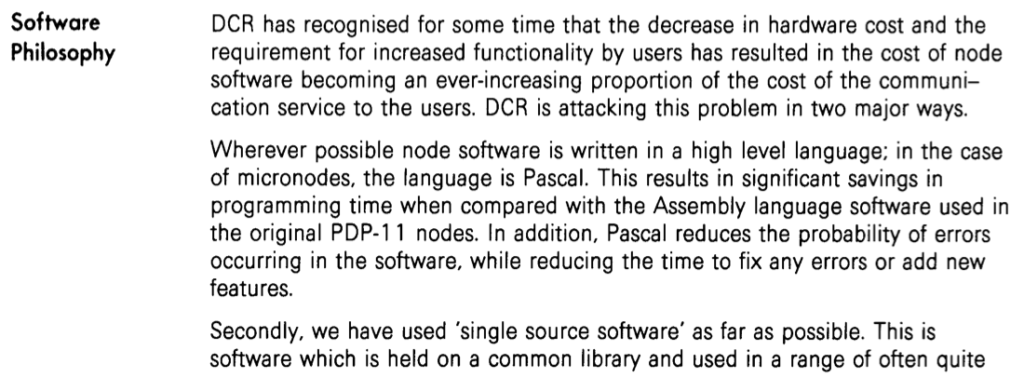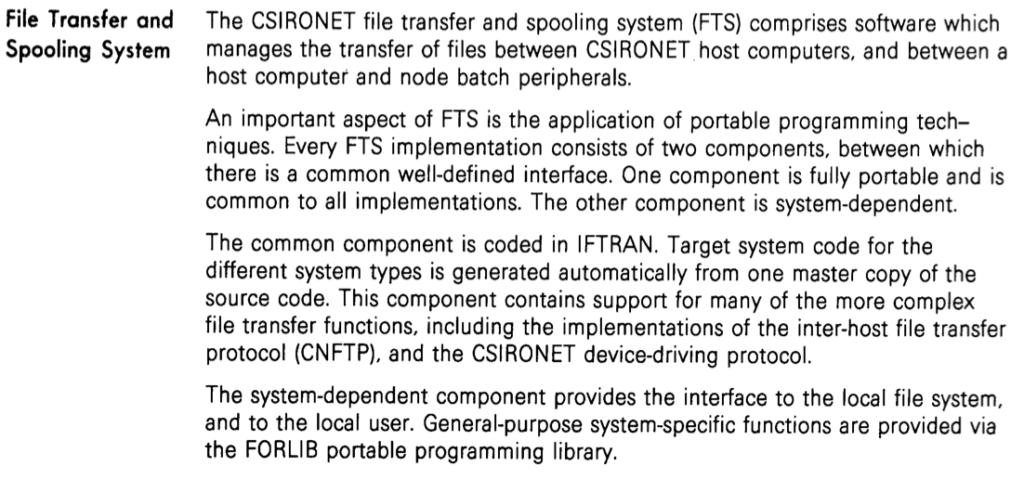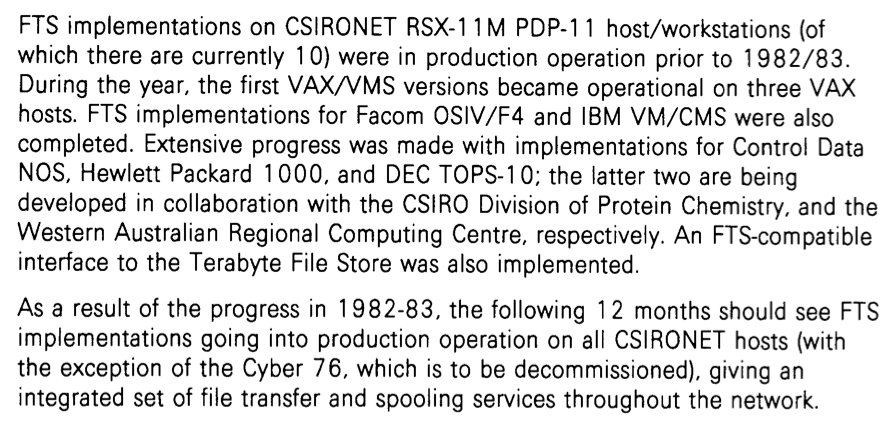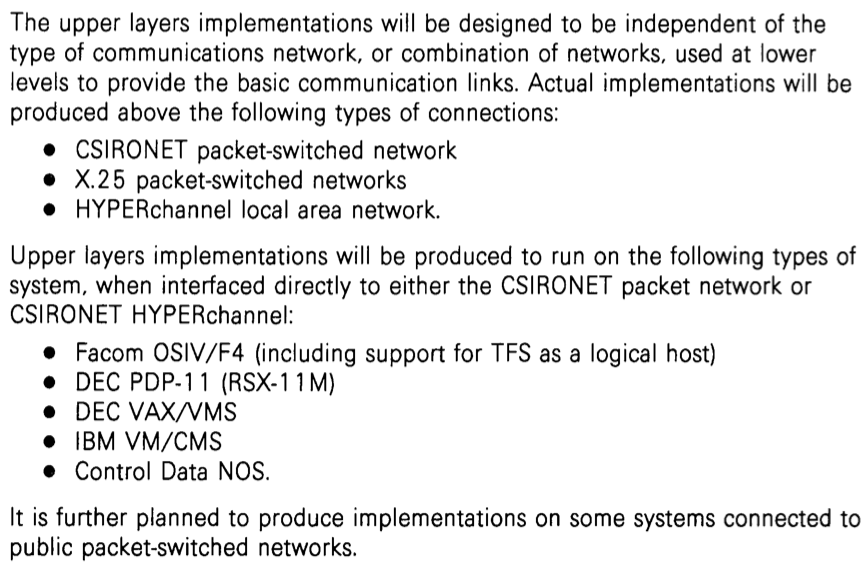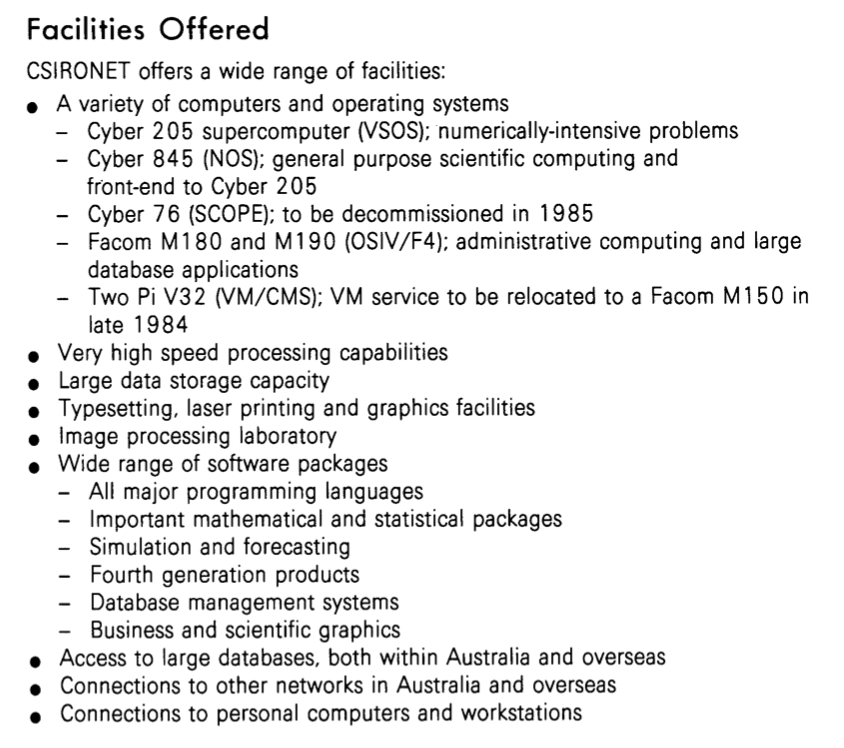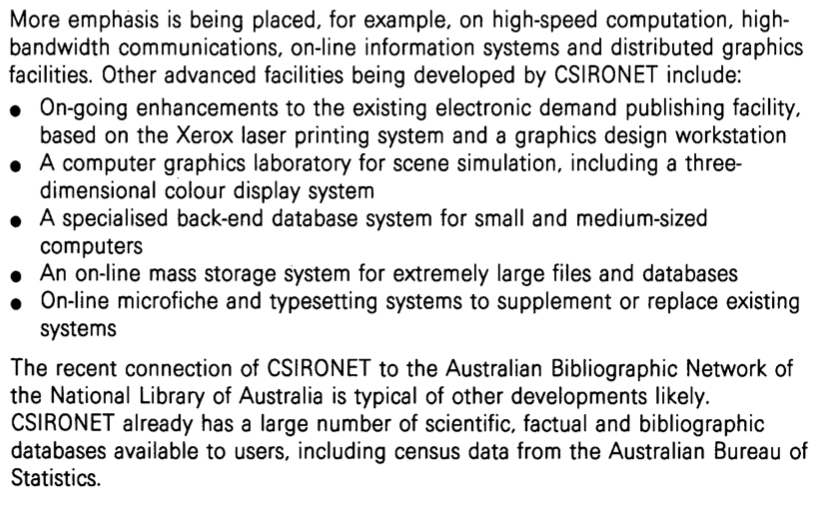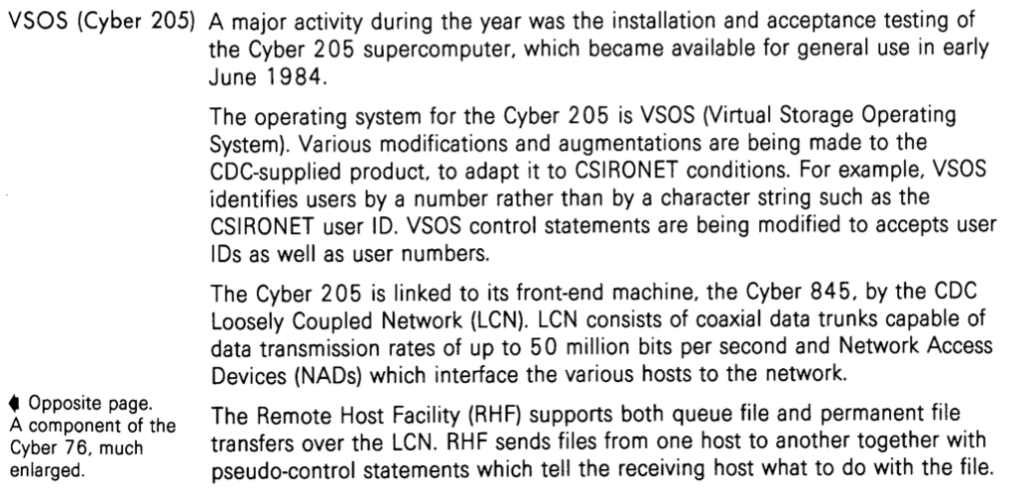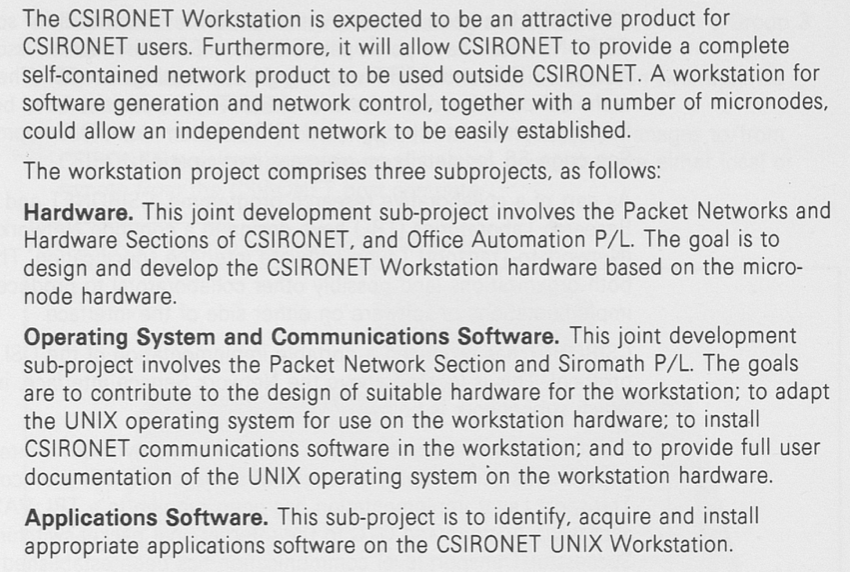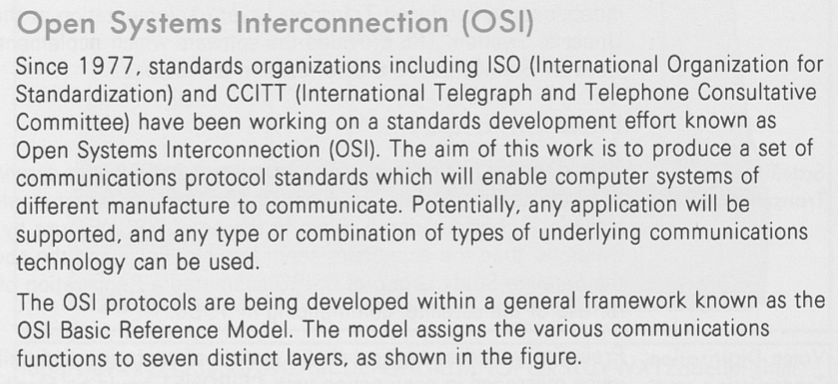CSIRO Computing History: Sidebar 2: The start of the on-line network
Last updated: 1 Dec 2020.
Robert C. Bell
Status: First pass complete.
previous chapter — contents — next chapter
(See also Chapters 2 and 3 of this history for the wider context.)
Trevor Pearcey in his 1948 paper “Modern Trends in Machine Computation” wrote:
This clearly envisaged a network of computers.
In 1962, a proposal from Trevor Pearcey with the support of E.A. Cornish from DMS for the establishment of a ‘network’ of computing facilities was approved by the CSIRO Executive, and received government funding. CSIRO established a Computing Research Section on 1 January 1963.
The contracts for the equipment and building were announced in CoResearch in July 1963 – see CoResearch no. 52 July 1963 and in newspapers such as this announcement from the Sydney Morning Herald. Network was the first key word!
CSIRO established a service in 1964 based on a CDC 3600 on Black Mountain in Canberra, and CDC 3200s in Melbourne, Sydney and Adelaide.
The original plan was for the CDC 3600 in Canberra, and four subsidiary machines, one in Canberra to handle input and output, and one each in Adelaide, Melbourne and Sydney – see The scientific computing network 1. The Central Laboratory – CSIRO Computing Research Section, October 1963.
It was notable that a network was the concept and name used from the start.
The plan was amended to drop the Canberra 3200, and to add to the 3600 a drum rather than the initially-envisaged disc storage, and to add visual displays, with Memoranda 1 and 2 dropped and replaced by Memorandum 4. Later, a disc store was added as well.
The opening was announced in September 1964 CoResearch:
and highlighted on the front page in October.
More details were provided on page 2: see https://csiropedia.csiro.au/wp-content/uploads/2018/09/coresearch_1964.pdf
C.S.I.R.O. Computing Research Section – Newsletter No. 12 – 1.5.66
This was a lightweight newsletter, as there was probably a lot of activity preparing for:
CRS was still working towards a unified network, and the above illustrates a first approach to conditional compilation, using the job-stacking program which would now be called a preprocessor to a language. Maintaining multiple versions of code for different environments is an on-going problem.
C.S.I.R.O. Computing Research Section – Newsletter No. 13 – 1.6.66
DAD had arrived! It was not just the addition of drums and displays, but the introduction of time-sharing!
(The unlabelled icons are for cards and paper tape).
Here is the beginning of two vital concepts – the storing of information in ‘permanent’ on-line digital storage, and interactive access to documents and processing power: both concepts are now so mainstream we barely think about them!
C.S.I.R.O. Computing Research Section – Newsletter No. 15 – 1.8.66
This was the beginning of interactive access – at this stage, the only consoles were at the Computing Research Section in Canberra.
The on-line system allowed for interactive development, visualisation and steering of programs.
C.S.I.R.O. Computing Research Section – Newsletter No. 18 – 1.11.66
Access to the VISTA displays from Fortran programs was announced.
C.S.I.R.O. Computing Research Section – Newsletter No. 19 – 1.12.66
Here is another new concept – ‘output’ being able to be saved and viewed on-line from a console rather than automatically printed and the on-line copy discarded.
(The SCOPE and DAD operating systems used the concept of logical units for i/o, which were core to Fortran. The card reader was on unit 60, and output for printing was on unit 61.)
The locate request allowed documents to be found – an audit or listing capability. The display capability was fairly limited in its ability to work with saved documents on the drum, as shown by the commands above, but the CIDER command allowed inspection and editing.
 Peter Hanlon added (private communication Jan 2020): “A later development popular in Queensland provided job submission on Telex tape!”
Peter Hanlon added (private communication Jan 2020): “A later development popular in Queensland provided job submission on Telex tape!”

 Further branches were coming into operation, with Digital Equipment Corporation (DEC) PDP series being favoured (after the first installation of a PDP-8 in Canberra).
Further branches were coming into operation, with Digital Equipment Corporation (DEC) PDP series being favoured (after the first installation of a PDP-8 in Canberra). The idea of daily turnaround seems primitive, and yet that is often the case now for users of shared HPC systems that are heavily loaded!
The idea of daily turnaround seems primitive, and yet that is often the case now for users of shared HPC systems that are heavily loaded!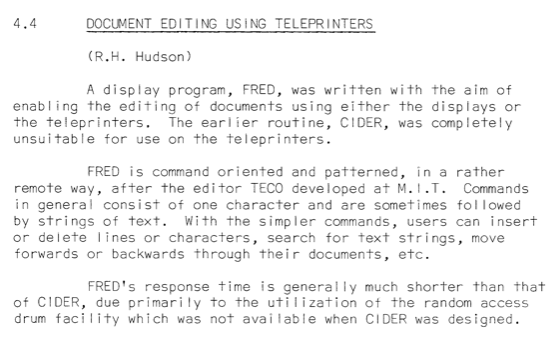 Thousands of people will have used FRED and its successors Ted and Ed, including programming using boxes, which could hold text and/or commands.
Thousands of people will have used FRED and its successors Ted and Ed, including programming using boxes, which could hold text and/or commands.
The September 1968 Newsletter reported that “Circuitry for the connection of remote Teletypes to the 3600 via the PDP-8 is now complete. A Teletype using this system is now in daily use at the Division of Land Research in Canberra to execute and edit programs, The installation of Teletypes at a greater distance awaits P.M.G. type-approval of the equipment and the availability of lines.”
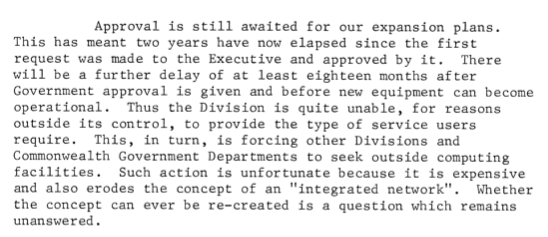 This became a recurring theme over the years: lack of finance for expansion to meet the needs.
This became a recurring theme over the years: lack of finance for expansion to meet the needs.1969-70 – wide-area network=CSIRONET, computer-to-computer link
CSIRONET
DCR developed a packet-switched network from about 1969, the year the DARPANET was started (which became the Internet). Over time, users could have remote card-readers, printers, plotters, and paper-tape readers and punches, and teletypes or visual terminals attached to a local node (PDP-11). Ten characters per second was the standard speed for teletype terminals, with 30 characters per second for display terminals being considered fast. Most CSIRO sites acquired the basic node, card reader and printer, and often had a DCR staff member as operator by the mid-1970s. For example, Kay Challis at Aspendale.
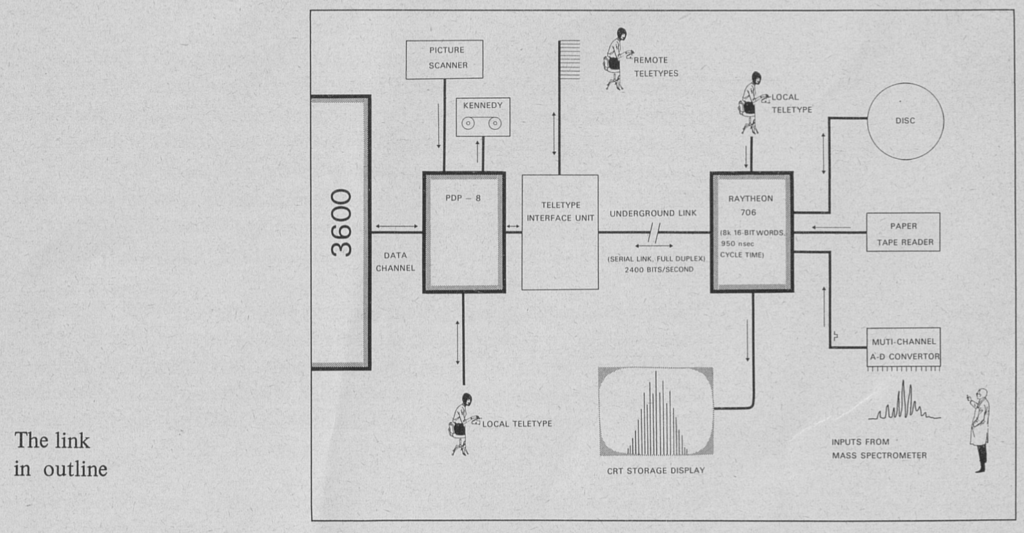
1970-71 – job submission via telex, start of network project, interstate lines, PDP-11s
The 1970-1971 Annual Report can be found here.
Townsville was like Perth, in having a PDP-8 to provide access to a nearby university’s PDP-10.
Who would think now that people would use a service to submit jobs using paper tape and a machine on the telex network, which was primarily used for business communications!


The big item for the year was the commencement of the network project, based on earlier work involving the PDP-8 front-end to the 3600. This planned to allow remote job entry and output to the 3600 in Canberra from the branches, and allow remote interactive access for the first time.
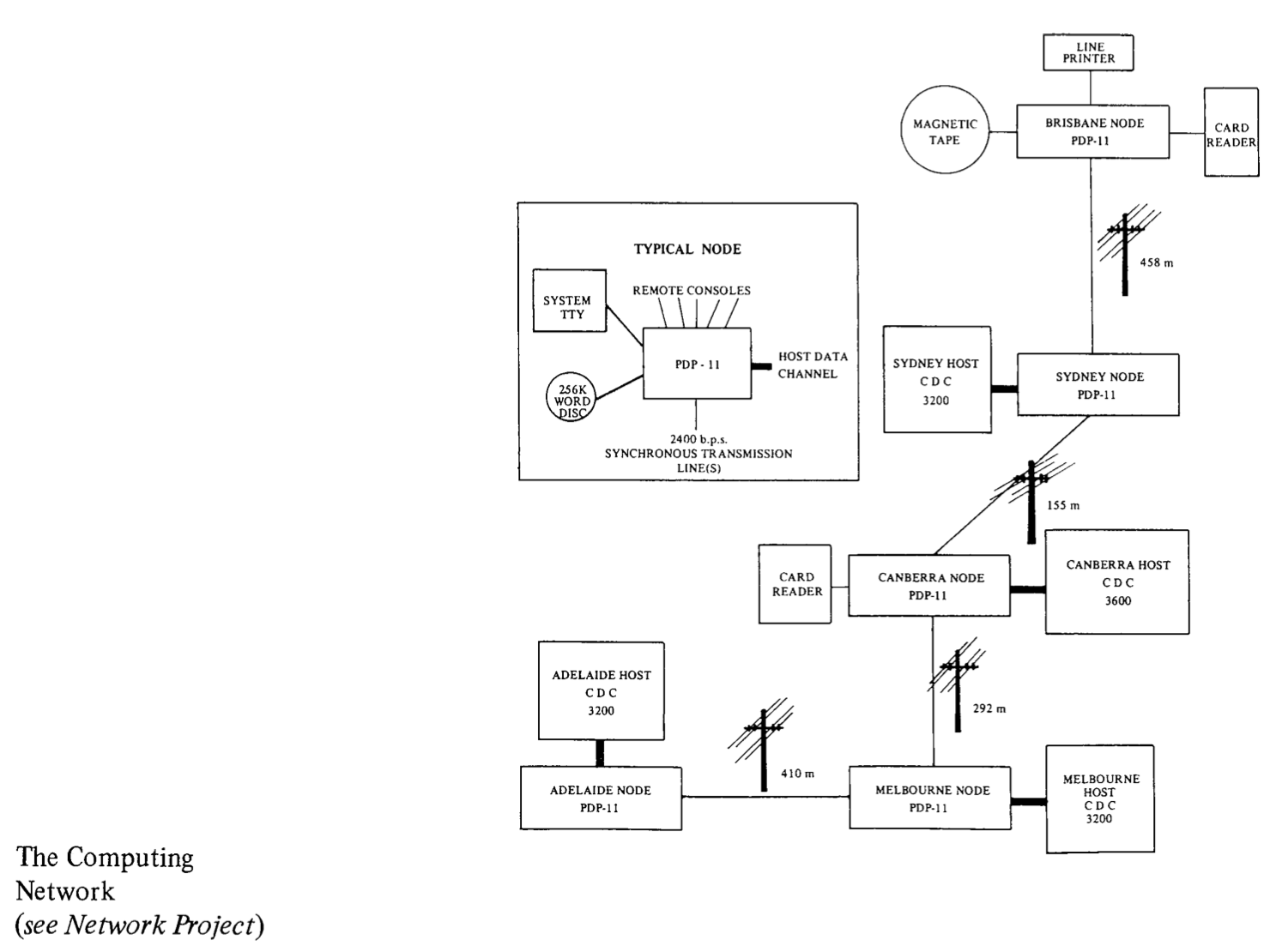 CSIRO was one of the first organisations to make use of the interstate telephone network for data traffic – a speed of 2400 bit/s to each node was planned.
CSIRO was one of the first organisations to make use of the interstate telephone network for data traffic – a speed of 2400 bit/s to each node was planned.
CSIRO wrote its own monitor (operating system) for the PDP-9 at Griffith, to allow time-sharing.
DCR was facilitating the use of small computers in CSIRO Divisions, and hosted a 3-day workshop in November 1970. This led to study groups to work in specific areas. Doubtless, some of the work found its way into the future CSIRONET network facilities, and some led to heavy usage in Divisions of local computers for data acquisition, etc.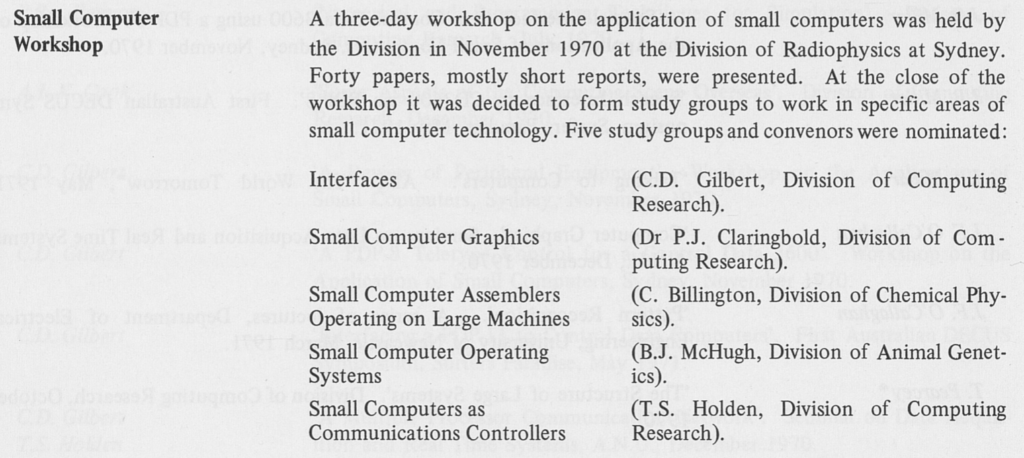
As well as the porting of DAD to the system at Computer Center Santa Barbara as reported in chapter
1971-72 – CSIRONET in operation, PDP-11 nodes at branches, reentrant FRED
The 1971-1972 Annual Report can be found here. The contents page is similar to previous years, and there were no new branches (but see below):The network came into operation under the name CSIRONET:  Here is the list of consoles: most major CSIRO sites had access, along with several Government Departments.
Here is the list of consoles: most major CSIRO sites had access, along with several Government Departments.
Despite the listing of branches under the contents, there was a new branch started in Rockhampton.
The major branches acquired PDP-11s to act as nodes. The start of service date of April 1971 seems at odds with the CoResedarch announcement of service commencement in April 1972.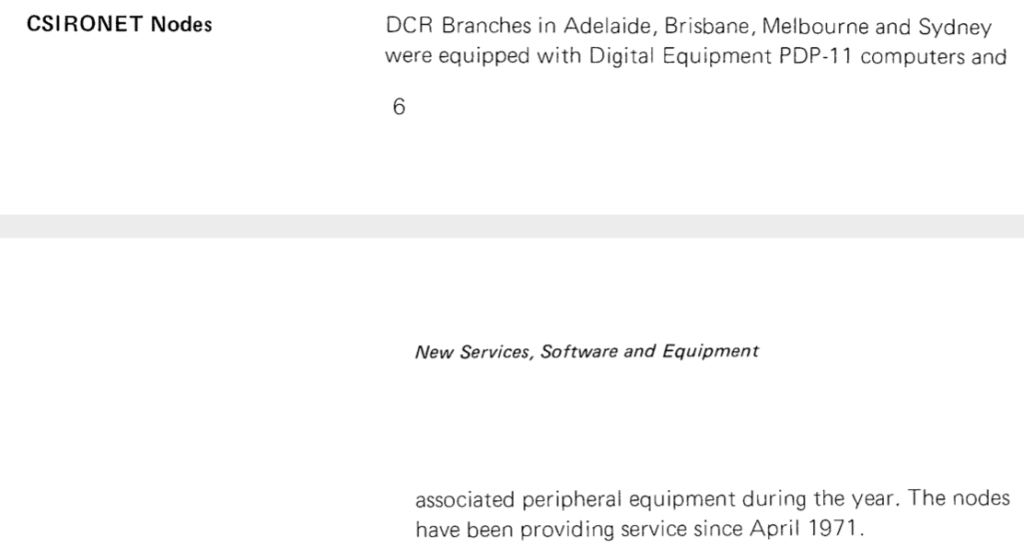
CSIRO wrote its own monitor (operating system) for the PDP-8/I in Perth, to allow time-sharing.
 Development of DAD continued: additional disc and channels, support for up to 70 interactive ports, improved scheduling, reentrant code, and the virtualisation of the Document Region spanning drums and disc, with overflow to magnetic tape,; and system reliability (to support interactive use).
Development of DAD continued: additional disc and channels, support for up to 70 interactive ports, improved scheduling, reentrant code, and the virtualisation of the Document Region spanning drums and disc, with overflow to magnetic tape,; and system reliability (to support interactive use).
CoResearch 157 April 1972 announced the start of operations of SIRONET (later CSIRONET, then Csironet).
Interactive access was supported by a CSIRO-developed text editor called FRED (then TED and later ED). Henry Hudson was the main developer. Versions for the Cyber 76 (Ed, using the additional LCM) and FRED for PDP-11s were developed).
1972-73 – Extension of CSIRONET to provide local nodes, TED replaces FRED – boxes
CoResearch 170, July 1973, highlighted the arrival of the Cyber 76 qnd the intention to plug it into the ‘CSIRONET’ network.
The September 1973 Newsletter noted that:
Cyber 76 installation started 9 June
Acceptance tests started 29 June
Acceptance tests completed 13 July
CSIRONET/Cyber magnetic tape link operational 18 July
CY link operational 13 August (DAD system – SCOPE 2.0 system)
CO link operational 22 August (SCOPE 2.0 system – DAD system).
(SCOPE 2.0 was the operating system on the Cyber 76).
Also noted:
“The communications lines of CSIRONET are currently:”
– 8 links were listed between the mainland capitals and Cronulla, Rockhampton and Townsville, with speeds of 2400 bps or 4800 bps (bits per second).
The 1972-73 DCR Annual report can be found here.
As well as funding for the Cyber 76, funding was in place to expand CSIRONET, so that most Divisions would have remote job entry and interactive access.
Development continued on the DAD operating system, primarily to support the Cyber 76 and the growing network
The FRED editor which was written for the early display consoles, was replaced by TED, which supported a range of terminals, and had extended features.
Here’s an insight into the challenges of writing software for the PDP-11s that were used as nodes on the network – all in assembler, and cross-compiled from the Cyber 76.
1973-74 – CSIRONET: 30 nodes, delays in lines for network, Remote Access Group
The 1973-74 DCR Annual report can be found here.
The introduction more than hinted at the difficulties faced by the Division in bringing the Cyber 76 into service: chief among these were the work faced by users in converting to the new machine. Further problems arose from delays in the provision by the Post Office of transmission lines, the problems of maintenance of the PDP-11s being used for intensive communications tasks, delays to new accommodation and staff shortages. On a positive note, the year was the first of a three-year expansion program, and Regional Computing Committees were set up. Finally, the introduction included the goal “to provide the Australian scientists a computing service comparable to the best in the world.”
Also described was the expansion of CSIRONET.
The growing importance of the network led to a separate group being formed.
 Under the “Summary of Computer Equipment” section, the definition of a basic node of the CSIRONET network was noted.
Under the “Summary of Computer Equipment” section, the definition of a basic node of the CSIRONET network was noted.
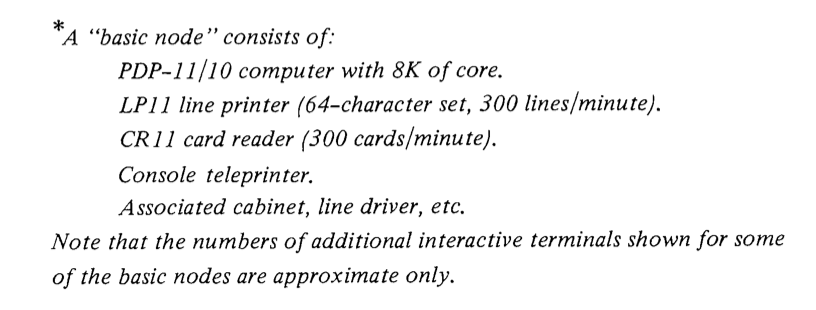
Back to start of 1973-74 Back to top
1974-75 – CSIRONET: 50 PDP-11 nodes, 48 kbit/s trunk lines, custom host-network interfaces
The 1974-75 DCR Annual report can be found here.
CSIRONET (the network) continued its evolution, with 48 kbit/s inter-capital links, and all sizable user groups having an on-site or nearby node.
DAD and the 3600 continued to support interactive and central input/output facilities.
CSIRONET continued to expand in size, in speed, in resiliency and reliability.
DCR continued to embark on targetted hardware development to support its unique network. The last paragraph hints at future developments to replace the 3600’s roles.
By 1975, Csironet was well established. A paper by Colin D. Gilbert, The Evolution of Csironet, noted that:
The paper included a map showing the extent of coverage and the connection path from the Cyber 76 to a sample node:
There were plans to install two CDC Cyber 172s to take over the front-end role of the 3600 (DCR Newsletter 104, June 1974), but these plans were abandoned. Instead, the 3600 continued in service for several more years, extra LCM was installed on the Cyber 76, and an interactive subsystem (CYI) was built to run on the Cyber 76, along with a new version (Ed) of the TED editor.
1975-76 – CSIRONET: 43 nodes, multi-host development, peripheral driving, NODECODE exported; preparation for 3600 end: Cyber 76 and node enhancements
The 1975-76 DCR Annual report can be found here (78 pages).
The following observation highlighted a milestone in the growing proportion of the computing done by non-CSIRO users: unless this was considered part of CSIRO’s mandate to help industry, it was not CSIRO’s core business, and in any case, most of the non-CSIRO usage was from government departments.
More storage was acquired, and Csironet continued to grow. The CDC 3600 was clearly nearing the end of its life, but was a core component of the network and services. Many of the subsequent pages of this annual report highlighted work underway to replace this functionality with services run primarily on the Cyber 76 under SCOPE 2, which was never designed for such interactive, network-focussed, real-time, and direct user interaction. It was a challenge.
Some of the new facilities under development included:
- a simulator for the Cyber 76 SCOPE operating system, allowing the withdrawal of the 16:30 test period
- development of a Cyber 76 Peripheral Processor programs to interface with CSIRONET – batch, interactive and test
- development of a ghost station on the Cyber 76, to replace the 3600
- integration of local modifications (23,000 lines) into each new release of SCOPE
- development of Cyber 76 replacements for TED (interactive) and RIO (remote input/output). These were developed as user-level jobs, with additional locally-implemented privileges
- the creation of an event processor, which allows messages to be passed between jobs
- development of the Cyber 76 hardware Maintenance Control Unit to allow it to be used for software maintenance and as an operator console.
- automated pack assignment
- automated tape label writing
- magnetic tape reservation
- magnetic tape audit and inventory
- accounting changes, including showing itemised resource usage and cost for each job – see the example Cyber 76 job dayfile listing at here.
- generalisation of the accounting systems
- interactive preprocessors, particularly for Document Region (3600) and permanent file (Cyber 76) backup
- generalisation of CSIRONET, to support multiple hosts (not just the 3600), and to provide connection to the Cyber 76 as one of the hosts
- connection of the COMp80 to the central hosts
- System Performance Analysis and Resource Monitoring
- Reference Indexing Interrogation
And, here is another export success:
Here’s another major piece of work allowing the network to become multi-host:
1976-77 – 3600 nearly phased out, Ed replaces TED
The 1976-77 DCR Annual report can be found here (89 pages).
General access to the CDC 3600 was disabled in May 1977, with most of its functions by then transferred to the Cyber 76.
Apart from the Chief change, the major work reported was headed by:
The Summary of computing equipment reported 392 connected terminals, 6 dial-up ports, and 18 auxiliary computer connections. It listed the nodes and the equipment at the DCR-managed ones. One of the nodes was at the Reserve Bank in Sydney.
1977-78 – 2500 users, CSIRONET: 68 nodes
The CDC 3600 system was de-commissioned in the second half of 1977.
The 1977-78 DCR Annual report can be found here (80 pages – original was 76pp + covers, but some pages are repeated and pairs of landscape pages are rendered as single pages. Pages 1-34, then 43-44, then 33-76 are present).
 It was frustrating as a user in those years to have the experience (it seemed frequently) of losing the current work when the network or host system failed.
It was frustrating as a user in those years to have the experience (it seemed frequently) of losing the current work when the network or host system failed. 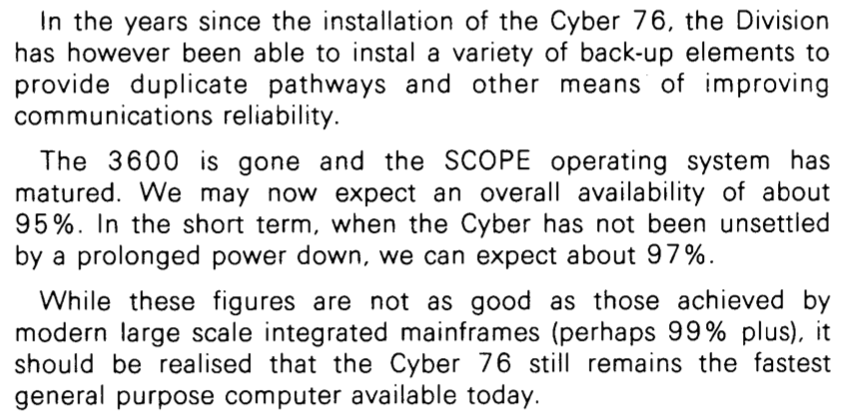 DCR worked on providing better reliability, and the Cyber 76 version of Ed could recover an editing session if the Cyber 76 or network went down (planned or unplanned).
DCR worked on providing better reliability, and the Cyber 76 version of Ed could recover an editing session if the Cyber 76 or network went down (planned or unplanned).
Both the Communications Systems Group and the Csironet network continued to expand, with staff now numbering 13, 68 nodes in operation, 584 connected terminals and a growing number of PDP-11s in service.
Support for card punches and cassette tape drives on the network were new items, illustrating the passing of the old and the introduction of consumer storage devices, allowing a maximum of 263000 characters per side.
With local nodes in operation, two DCR offices were closed, with operations being taken over by the local Divisions.
1978-79 – FACOM joint development project; NSC Hyperchannel and ATL; CSIRONET: distributed services, links to USA, 96 nodes
The 1978-79 DCR Annual report can be found here (82 pages).As the networking capabilities spread, it was feasible to establish R&D sections away from Canberra, but the Rockhampton office was closed.
This year was the start of the Fujitsu/FACOM era, with a joint R&D agreement, and DCR acquiring ‘mainframe’ capabilities more suited to data processing compared with the scientific computing power of the CDC systems. The development of capabilities around the NSC 50 Mbit/s Hyperchannel was the first project: contrast that speed with the interstate links of 48 kbit/s.
The network was spreading to remote areas, and being interconnected to international networks.

Developments were underway to allow CSIRONET to function and be controlled and monitored from multiple disparate hosts – especially PDP-11 systems running RSX-11. The i/o package, the Monitor and Alarm System, and the Network Information Logger were early examples. 
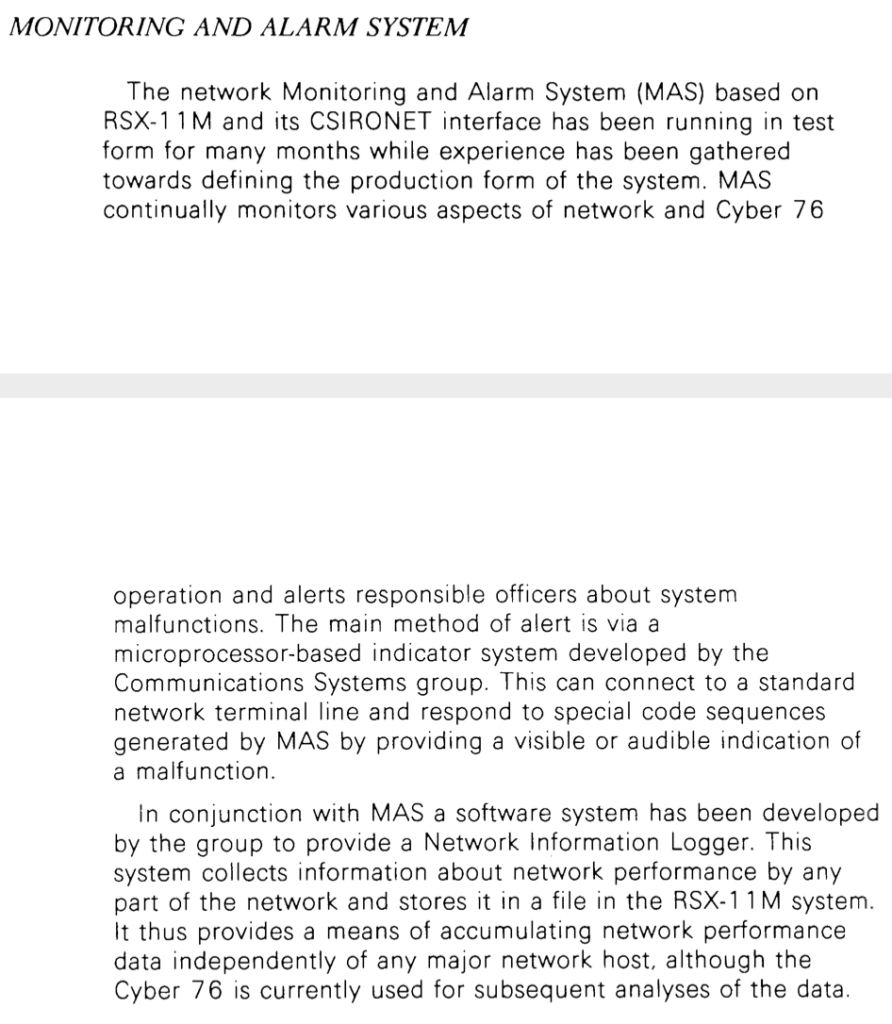
The first instance of an overseas CSIRONET node was reported.
Dial-up capability was an important advance for remote access.
With networks and the interfaces being far less reliable than today, the ability of the network to reliably restart output was an important advance.
DCR continued to undertake hardware developments to support the service, and was increasingly using microprocessor technologies. It had the expertise to find errors in equipment design and to design and build a terminal concentrator.
The first permanent interconnect was established with the MIDAS network.
CYI was the main interactive system running on the Cyber 76 – an entirely CSIRO DCR development, unlike any other in the world on a 7600 or Cyber 76. Support for 100 interactive users by the end of the 1970s was a major achievement, albeit with far slower communications links and limited capabilities, with most applications being text based. But, Tektronix graphical terminals were supported. With statistical analysis and artificial load generation, the limitations of file accesses under SCOPE 2 was uncovered.
Two major changes were made to circumvent these issues. The first was the development of the ED editor to support library files. These were originally in SCOPE 2 to support libraries of relocatables – compiled code of subroutine libraries, etc (partitioned data sets in IBM terminology). Whereas SCOPE 2 provided for permanent files to have filenames of up to 40 characters, and supported multiple cycles of files, the names of the members of a library could be at most 7 characters long, and had no cycle concept. DCR enhanced ED in many ways to support saving files in, retrieving files from, and auditing the contents of libraries. And, some genius provided a facility so that the Ed libraries could support a comment of up to 70 characters on each member. This became an excellent way to start building metadata around files, since users found that the 7-character limit was indeed very limiting (just as DOS not many years later was restricted to 8-character filenames, albeit
with a three-letter extension).
Workfile recovery was another major advance – less use of the PFM, and greater resiliency for users.
Both the network and the RIO system had to be enhanced to support the recovery mechanism.
Work commenced on the Joint Development Project with FACOM (the trading name used by Fujitsu for its computers).
1979-80 – CSIRONET: 102 nodes, inter-networking, Mail, microprocessors
The 1979-80 DCR Annual report can be found here (88 pages).
The introduction highlighted the restructure, the new equipment, the failure of the new building contractor, and the growth in users and connections.
Advances were being made in links to other networks.
Investigation commenced on high-speed links between widely-separated computers. The 34 Mbit/s microwave links came into use in CSIRO in the 1990s for linking CSRIO sites in metropolitan areas.
I’ve omitted the details of the achievements so far of the CSIRO-FACOM Joint Development Project, which included channel connections between the FACOMs and Cyber 76, the connection of CSIRONET terminals to the FACOMs, the installation of accounting systems, the development of a software design methodology, and the sharing of tape drives.
A Mail system was under development.

Developments using microprocessors were underway – these would lead to the development of the micronode, a far cheaper platform for CSIRO nodes than a PDP-11.
1980-81 – CSIRONET: 110 nodes, more gateways, microprocessor developments, encryption, software development
The introduction outlined key features of the year, highlighting the VLSI program.

The HYPERchannel project was enhanced to link further hosts, including a Cyber 730 at the Australian Tax Office via a 2.048 Mbit/s link. The link was at that stage used only for experimental purposes, not production, but I think the DCR Cyber 730 was on stand-by for the ATO.
Software development was clearly an issue of increasing importance, as the following item showed. Pascal was considered the language of the future at that time.
The CSIRONET Mail System was under development still.
Work was starting on porting the CYI interactive system to NOS/BE on the Cyber 730, in anticipation of the demise of the Cyber 76 eventually.
As the network expanded and continued to embrace more hosts, changes in the architecture were needed to support dynamic network configuration.
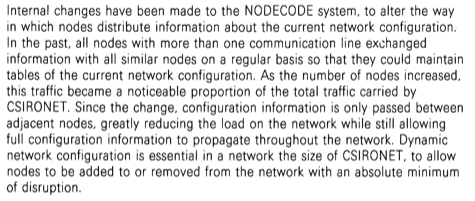
A project to unify messages from the network and hosts was underway, with message codes being implemented – a very OS/360 concept.
Security continued to be enhanced, with the now-common practice of storing encrypted rather than plain-text passwords for the validation of users.
After a decade of use, DCR had started the move away from the the PDP-11 nodes to microprocessor-based nodes.
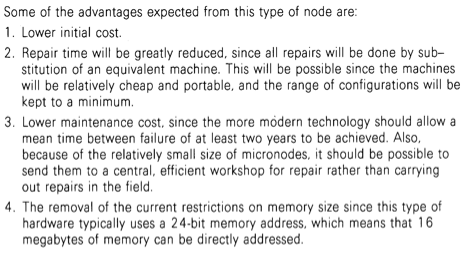
DCR continued to search for efficiencies in the software development processes.
Encryption was under consideration, possibly instigated to support customers like the ATO.
An early microcomputer was in use to control a switch.
1981-82 – CSIRONET – micronode development, 140 nodes, gateways (UNIX), first overseas node; improved software methodologies
The 1981-82 DCR Annual report can be found here (108 pages).
The contents followed a similar pattern to previous years, but a new feature was the CSIRONET Charter – the service received the CSIRONET branding.
The Introduction, over the Chief’s signature, outlined major events during the year.
An overseas CSIRONET node was a first.
The term ‘packet’ networks was now adopted as a name for the networking technology and group title.

Development of the micronode advanced, with a partnership with Office Automation being established. Plans were detailed of the deployment of micronodes and how they woudl operate in service.
The nodecode developments allowed interactive type-ahead for the first time – something very useful with the slow and unreliable links at the time. The CSIRONET Communications Protocol provided similar functionality to the TCP/IP protocols.
Software development and maintenance in support of the network continued to be an issue. It is remarkable that the bulk of the communications software was now written in a high-level language (Pascal), whereas the internet software was mostly written in C, which is lower-level (and subject to massive security holes). It was notable too that the CDC UPDATE source code management system was able to do the job, with just a few facilities – conditional compilation and the ability to *CALL common pieces of code – see the manual for the Cray version of UPDATE at https://archive.org/stream/bitsavers_crayUpdatenceManualNov90_5961134/SR-0013K_Update_Reference_Manual_Nov90_djvu.txt .
Here are more details of the first (and probably only) CSIRONET node in the USA.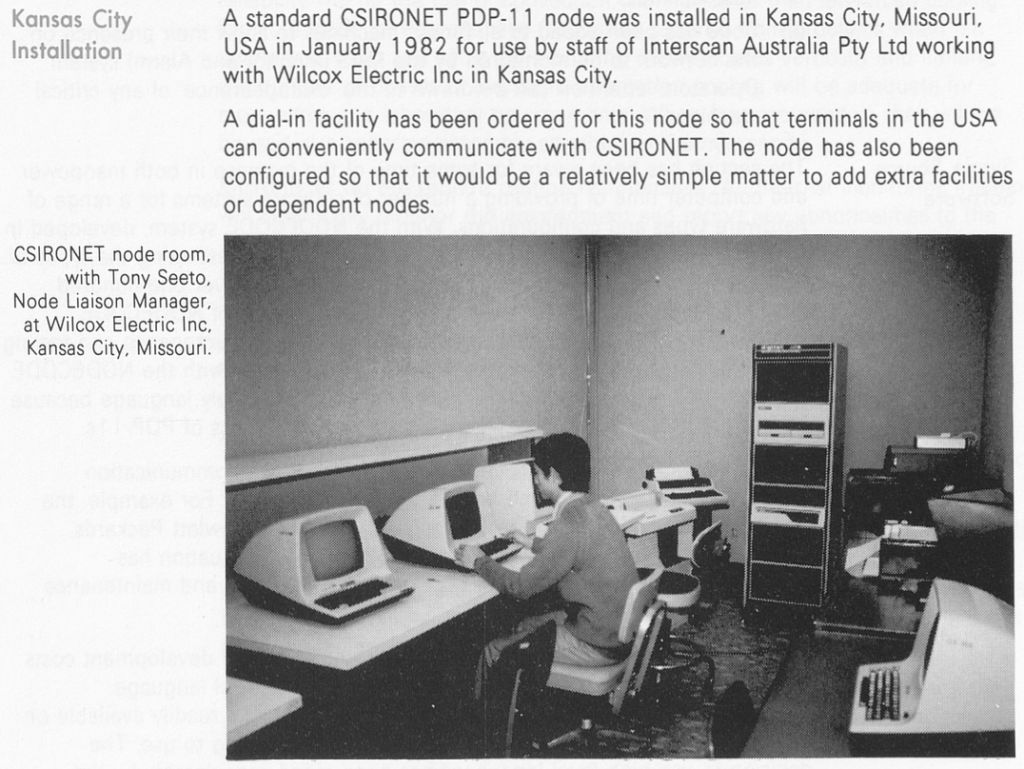
DEC VAX machines were popular follow-ons to the PDP-11 range, and DCR evaluated one. (There was another installed for the VLSI program.)
The network capabilities continued to be enhanced, with greater attention to ease of installation and generalisation of capabilities.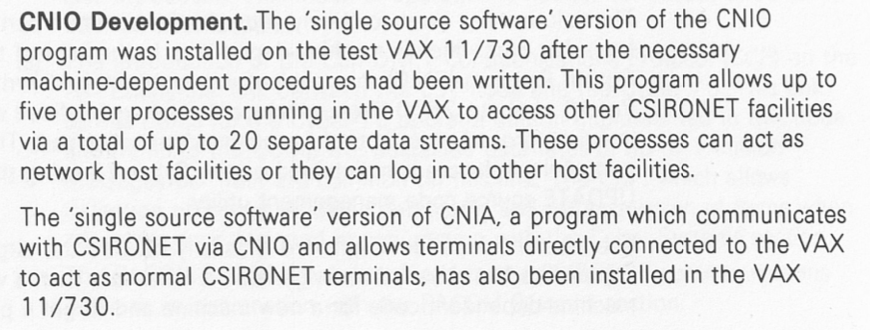
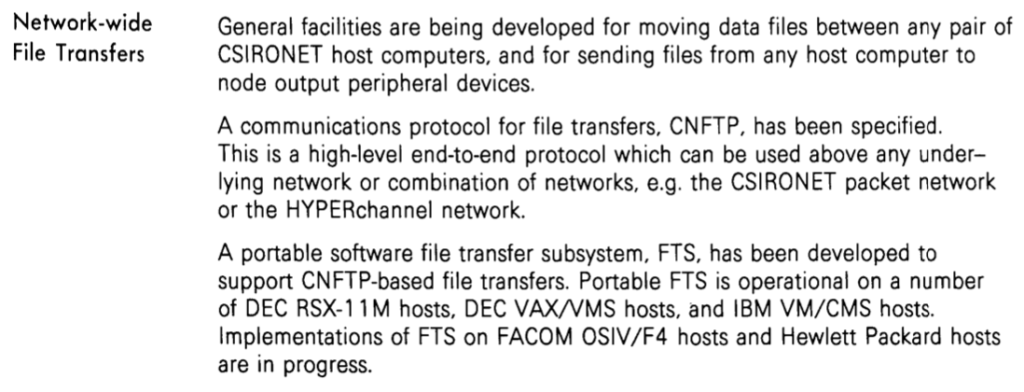
DCR had developed three kinds of gateways to allow connections between CSIRONET and other networks.
The first gateway was to the TYMNET network, the second to DECSYSTEM-10 ANF-10 networks at Australian universities, and the third to UNIX Systems, presumably running TCP/IP. There was a hint of DCR’s recognition that UNIX was ths way of the future, at least for 16-bit microprocessors.
An X.25 gateway was an under development, in the hope that this would become universal. It did not, being overrun by TCP/IP-based networks – a de-facto standard initially.
The interactive system was being ported to the lower Cybers, and given the macro language in which it was written, the porting was successful. 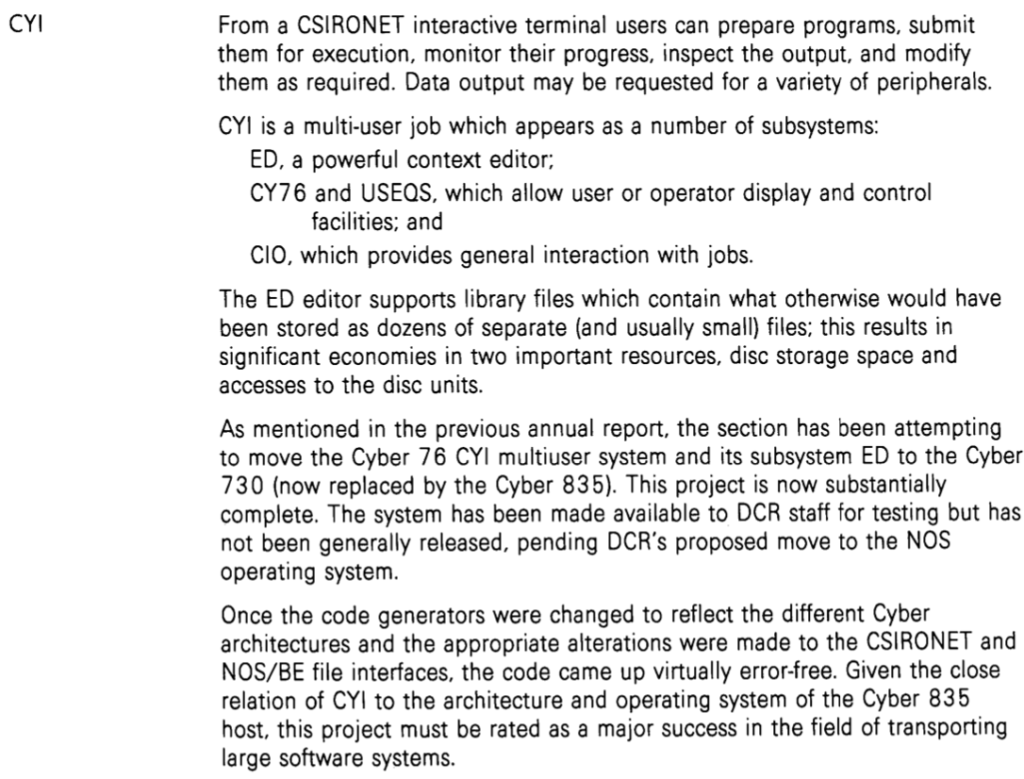
The Mail system was still under development.
The joint development project continued. The feasibility study into network-attached disc storage foreshadowed the development of SANs (Storage Area Networks) a decade later..
I’ve extracted two sub-lists from the list of CSIRONET Nodes. The ACT list shows the large extent of connection by Commonwealth Government Departments – 15 sites, with 8 non-DCR CSIRO sites, and 4 DCR nodes.
The list for Victoria shows connections to 15 CSIRO sites, and 11 other sites.
Here are some details of the main hosts available on CSIRONET at June 1982
| Host | Speed/MIPS | Memory/Mbyte |
|---|---|---|
| CDC Cyber 76 | 15 | 4.3 |
| CDC Cyber 835 | 4 | 7.5 |
| FACOM M-180N | 2 | 8.0 |
| FACOM M-150F | – | 4.0 |
| FACOM M-190 | 3 | 12.0 (sole use by Department of Social Security) |
| Two Pi V32 | 0.25 | 2.0 |
In addition, there were several VAXes and many PDP-11s.
1982-83 – CSIRONET – 141 nodes, micronode deployment, gateways, VAXes
The 1982-83 DCR Annual report can be found here (109 pages). The front cover showed a board from a micronode.
The announcement of the acquisition of a Cyber 205 was reported. It was envisaged that it would become the heart of a national facility, akin to NCI today. The demise of the Cyber 76 was foreshadowed
The move to replace PDP-11s with micronodes was underway.
Under the heading of Description of Programs, the following appeared, outlining the products and services supported on CSIRONET.
A key development was the mic ronode:
DCR was adopting better software development practices.
DEC VAX systems were widely deployed at Universities and there was a growing demand for these machines in CSIRO and elsewhere. DCR responded by developments aimed for hosting VAXen on CSIRONET.
In the years before the universal adoption of TCP/IP, it seems every new type of host required a project to develop communications interfaces.
Under the Network Architecture program was the following:
OSI developments were underway – these ultimately, like the CSIRONET network architecture, were over-run by TCP/IP.
More gateways between CSIRONET and other networks were developed and deployed. The ability to access mail facilities on other networks was highlighted.

![]()
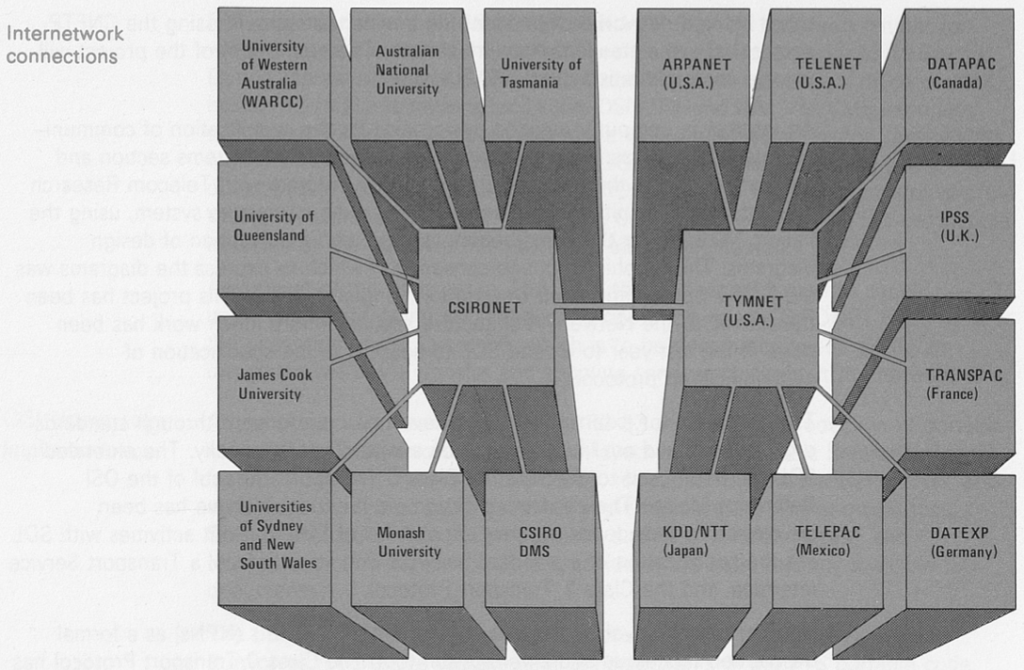
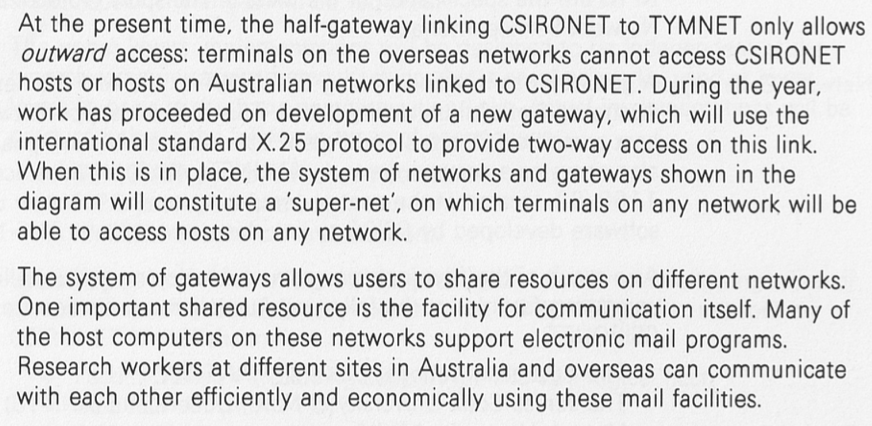
The PCC endorsed a plan to replace PDP-11 nodes with micronodes.

It seems that at this stage, commercial microprocessor-based systems were not able to meet the needs of a network mail server, but one was eventually chosen, allowing development to continue.

DCR was now running three Facom computers, with two for specific clients.
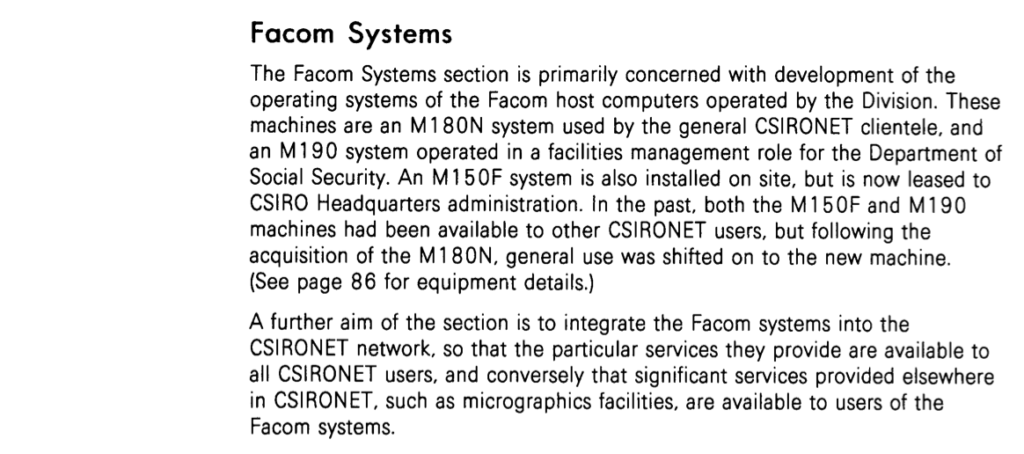 It seems curious that relocating datasets from one machine to another running the same operating systems system could be as difficult as suggested here. However, the IBM-compatible operating systems were rigid in many areas, including users having to define in detail the structure of the layout on storage – the CDC systems did this automatically.
It seems curious that relocating datasets from one machine to another running the same operating systems system could be as difficult as suggested here. However, the IBM-compatible operating systems were rigid in many areas, including users having to define in detail the structure of the layout on storage – the CDC systems did this automatically.
The work on network-attached storage came to an end – because of limited memory in the HYPERchannel adapters – but it would seem that the concept could have gone forward, and more memory could have been available at some future stage.
1983-84 – CSIRONET – 100 user nodes, micronode deployment, gateways, UNIX workstation
The 1983-84 DCR Annual report can be found here (78 pages). It was to be the last such annual report for the Division of Computing Research.
There was no contents list, and the text started with a long introduction spanning several topics.
Access was being widened, and support services continued. 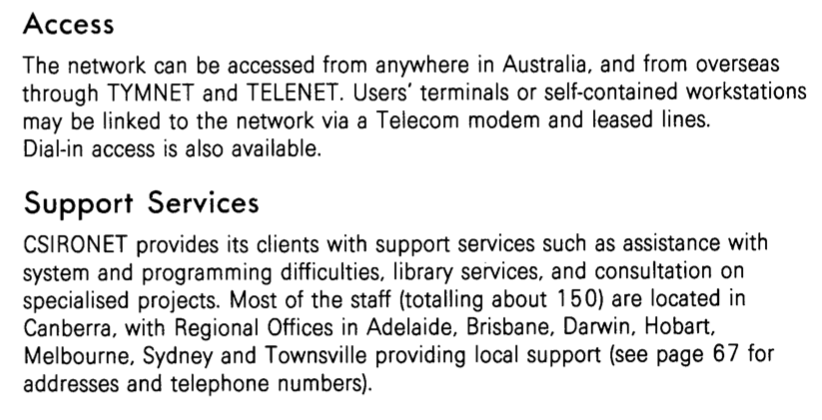
DCR was undertaking multiple collaborative R&D projects, mainly with the computing industry.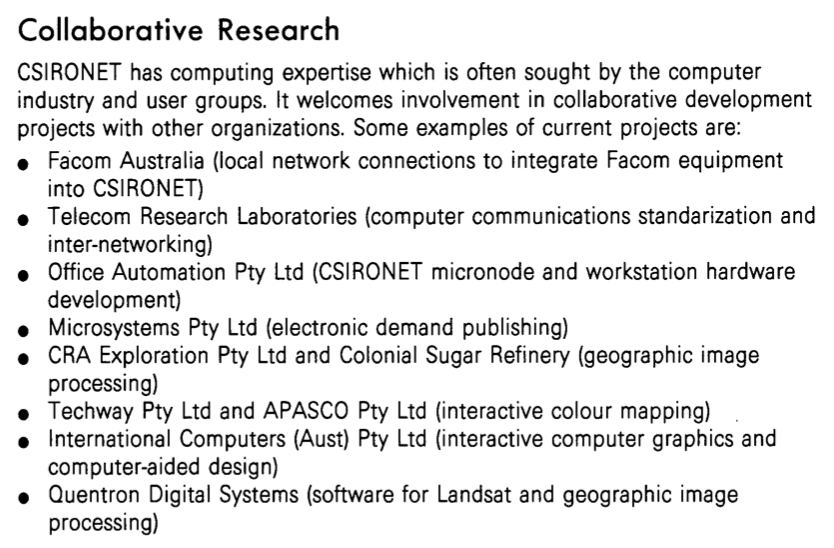
DCR highlighted again some of its specialist services.
The services were listed under the following major headings:
Host Services, CSIRONET Network, Communications Services, Data Storage, Specialised Services, User Services, Management Services, and Operations.
The network continued to evolve and grow.
It is interesting to see the growth in UNIX connections to become the most common.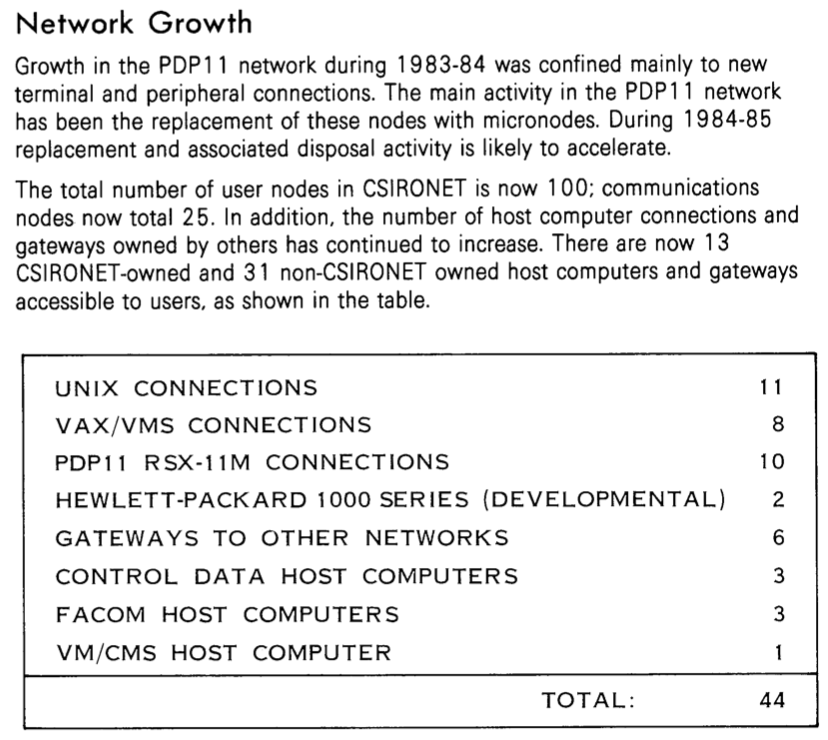

The fact that services were viable from Darwin to use systems in Canberra illustrated how far the network had progressed.
The R&D section noted the following:
The use of RHF was messy: sending directives from one host to another via the MFLINK command. Here’s an example of a job, submitted on the Cyber 845 for execution on the Cyber 205, that sends a file to the Cyber 845 for saving.
audit,stcyv. USER,U=CMPXjv,PA=jv,AC=CMPXJv,ppw=cmpxjv. RESOURCE,TL=40,jcat=deferred.audit <<<<<Robert Bell>>>>> attach,out. copyl,out,someout,part=r,number=6000. mflink,someout,st=cyn,dd=c6,jcs="user,cmpxrb,zkv.", "charge,cmp,cmpxjf.","define,someout.".
Work started in many areas to disentangle the Cyber 76 from its pivotal role in the services.
The field experience with the micronodes showed reliability better than predicted.
DCR did see the future in UNIX workstations, and started the process of enhancing the micronode for such a role. This was in the era when workstations were beginning to be widely deployed – systems from Sun Microsystems, Apollo, DEC, HP, Silicon Graphics, NeXT and IBM. Siromath was a spin-off from the Division of Mathematics and Statistics.
The Workstation project involved development of the hardware, porting of UNIX and enhancing it with CSIRONET communications software.
DCR was involved in network standards development, including a seven-layer model.
The Wikipedia article on the OSI model notes:
The design of protocols in the TCP/IP model of the Internet does not concern itself with strict hierarchical encapsulation and layering.[34] RFC 3439 contains a section entitled “Layering considered harmful“.[35]
and
The OSI protocol suite that was specified as part of the OSI project was considered by many as too complicated and inefficient, and to a large extent unimplementable.[37] Taking the “forklift upgrade” approach to networking, it specified eliminating all existing networking protocols and replacing them at all layers of the stack. This made implementation difficult and was resisted by many vendors and users with significant investments in other network technologies. In addition, the protocols included so many optional features that many vendors’ implementations were not interoperable.[37]
In hindsight, DCR jumped onto the wrong horse for future networking.
DCR started exploring the connection of fax machines to the network.
Numbers were given for the micronode rollout.
The Mail system was in production use for CSIRONET staff.
Barry Jones launched the micronode. (He also opened the Joint Supercomputing Facility, the successor to CSIRO for CSIRO scientific computing, in March 1990).
1984-85
At the beginning of 1985, DCR ceased to exist and was replaced by CSIRONET and the CSIRO Division of Information Technology.
The Cyber 76 was de-commissioned in 1985 after the Cyber 205 went into service.
Summary
Trevor Pearcey and others had a vision for a networked computing service in the 1940s. CSIRO built up a computing service almost from scratch in the early 1960s, acquiring staff, a site and systems to meet the needs of science, providing a network of 4 host computers in the ACT and 3 state capitals.
In about 1969, remote connections to the service became available, and a network service was rolled out in the early 1970s, based on DEC PDP-11 nodes and leased Telecom lines to the CSIRO Divisions and major customers. This allowed remote batch and interactive access.
The network evolved to allow multiple host computers and multiple services, such as *Mail.
The start of the CSIRONET network in 1969 was contemporaneous with the start of DARPANET, which become the internet.
At the end of 1984, DCR was split into a services organisation, CSIRONET, and a research arm, the Division of Information Technology, with CSIRONET placed on the basis of being a self-funding agency.
PREVIOUS POST:
COMING UP NEXT:



